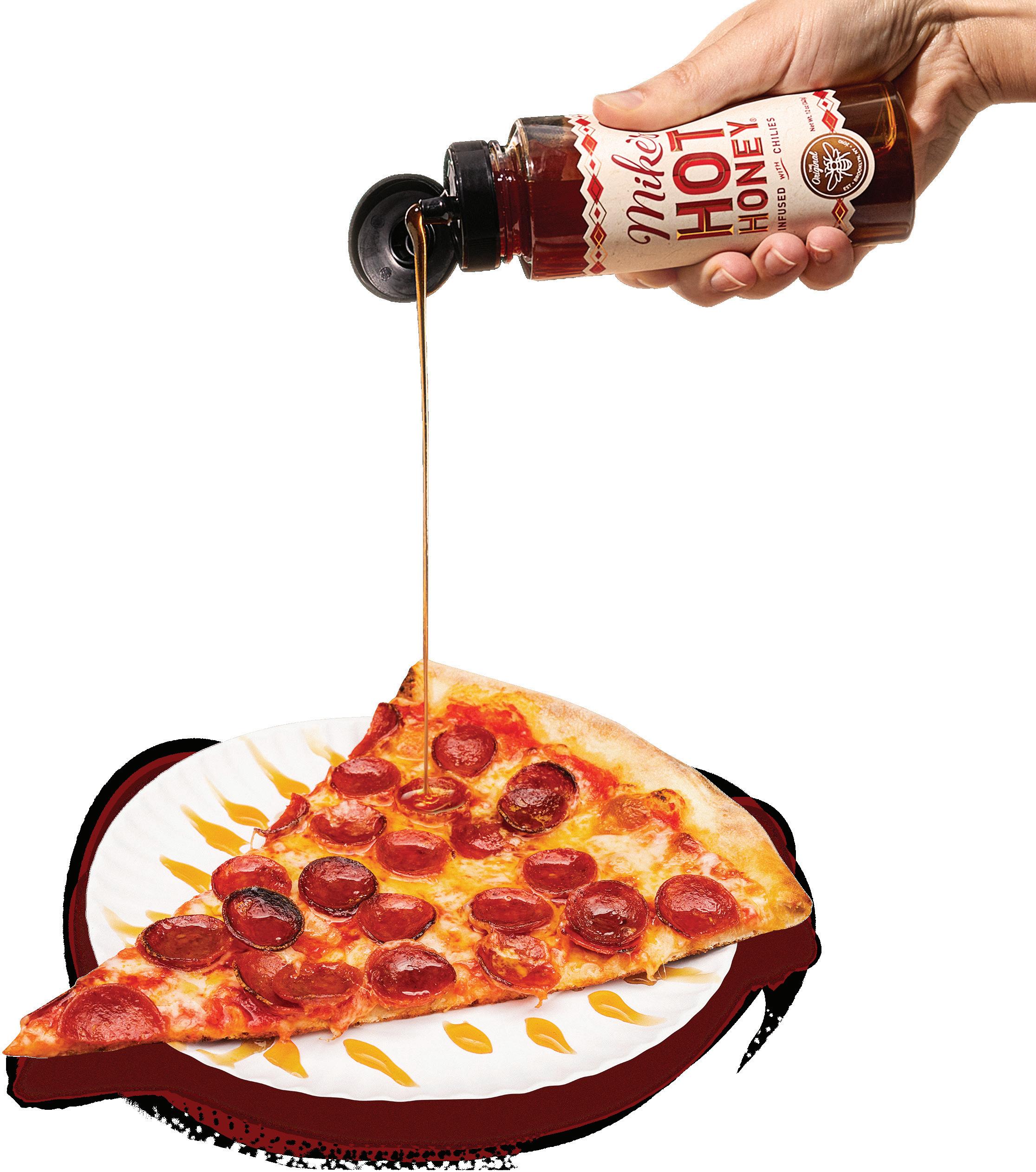
Building a Pizza Empire from the Ground Up 8 Deadly
Hiring Mistakes Restaurants Make: A No-Nonsense Guide
Is Franchising the Path for You?



Building a Pizza Empire from the Ground Up 8 Deadly
Hiring Mistakes Restaurants Make: A No-Nonsense Guide
Is Franchising the Path for You?

DOUGH BOY’S ERICA BARRETT dishes on “How to Optimize Your Tech-driven Pizza Concept,” on page 25.
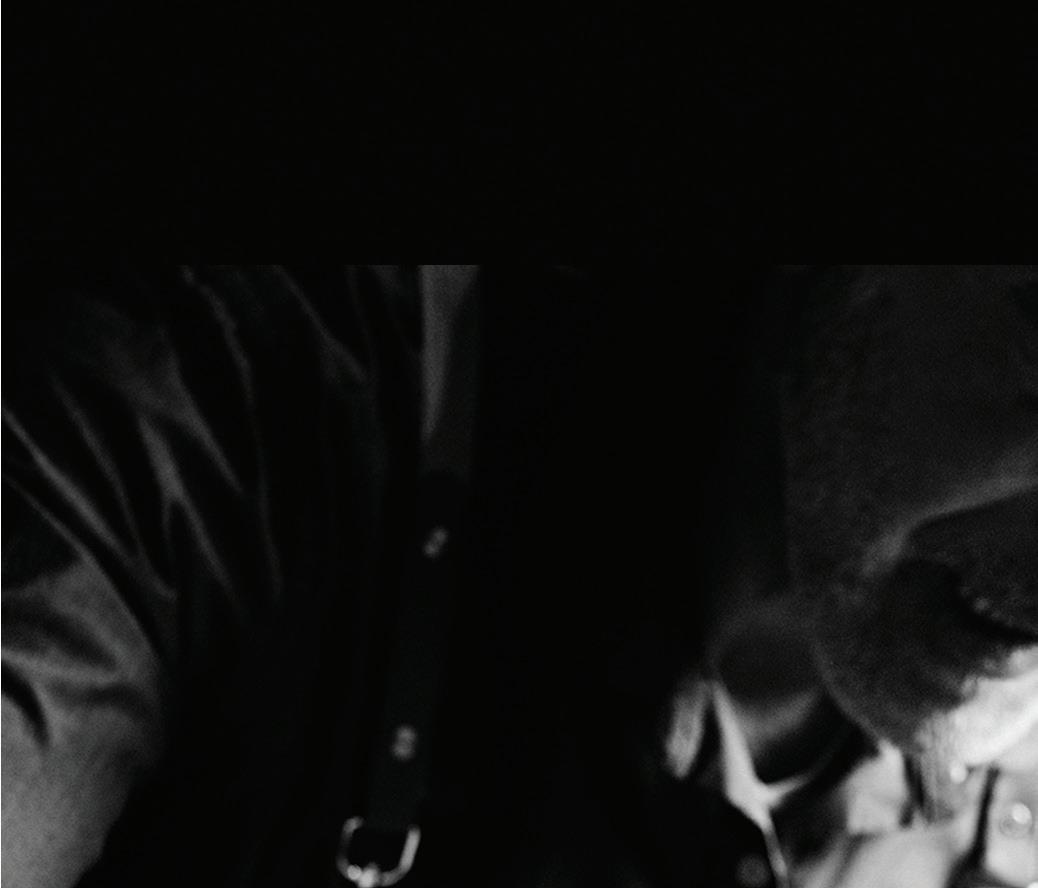
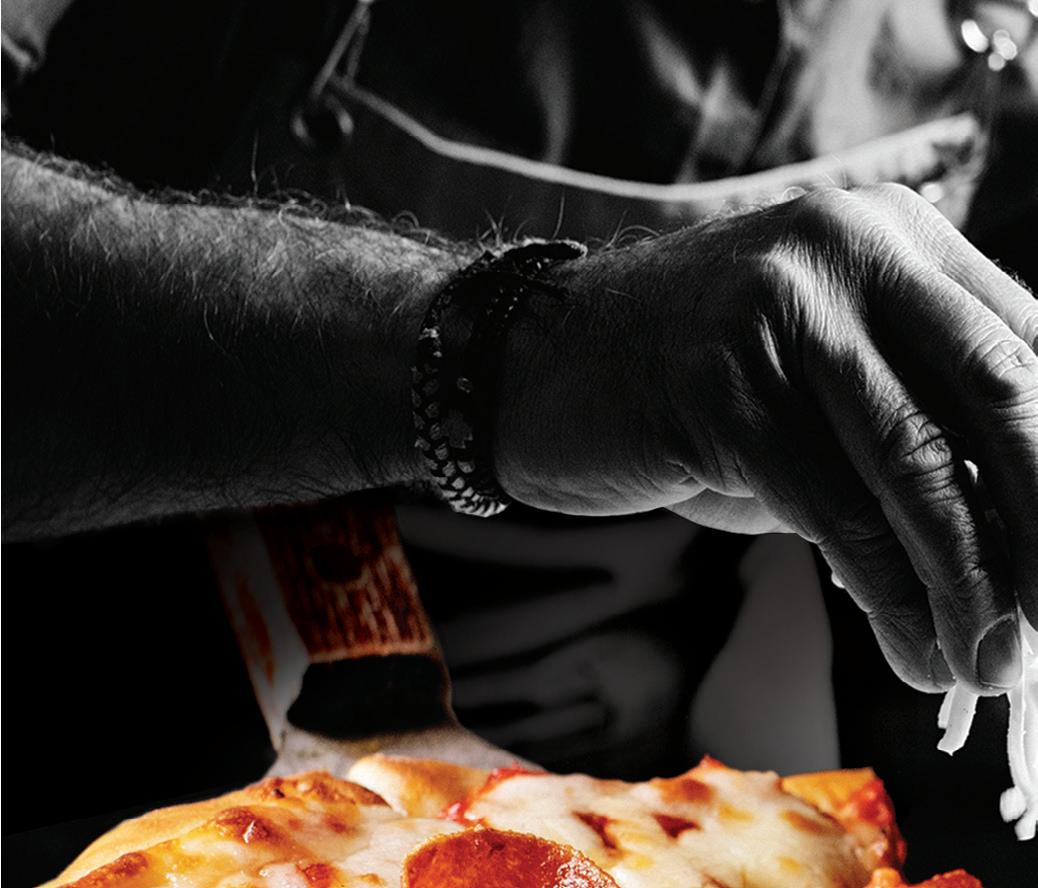
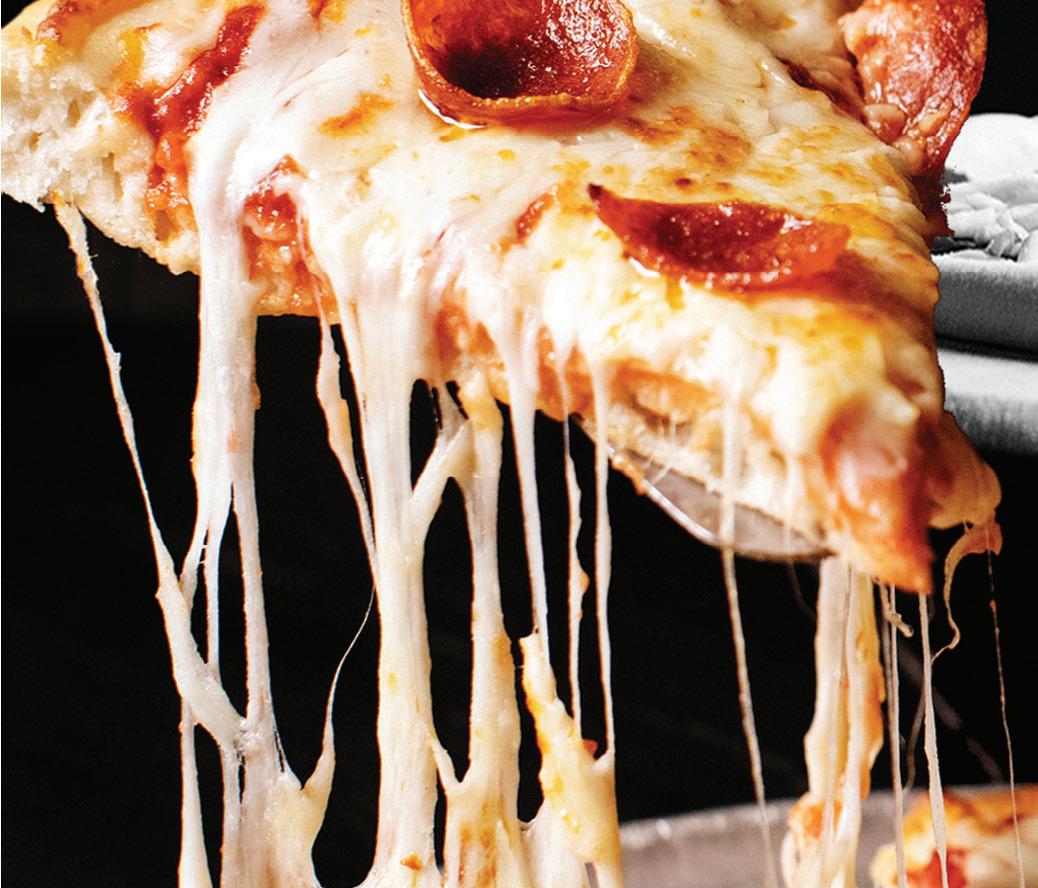
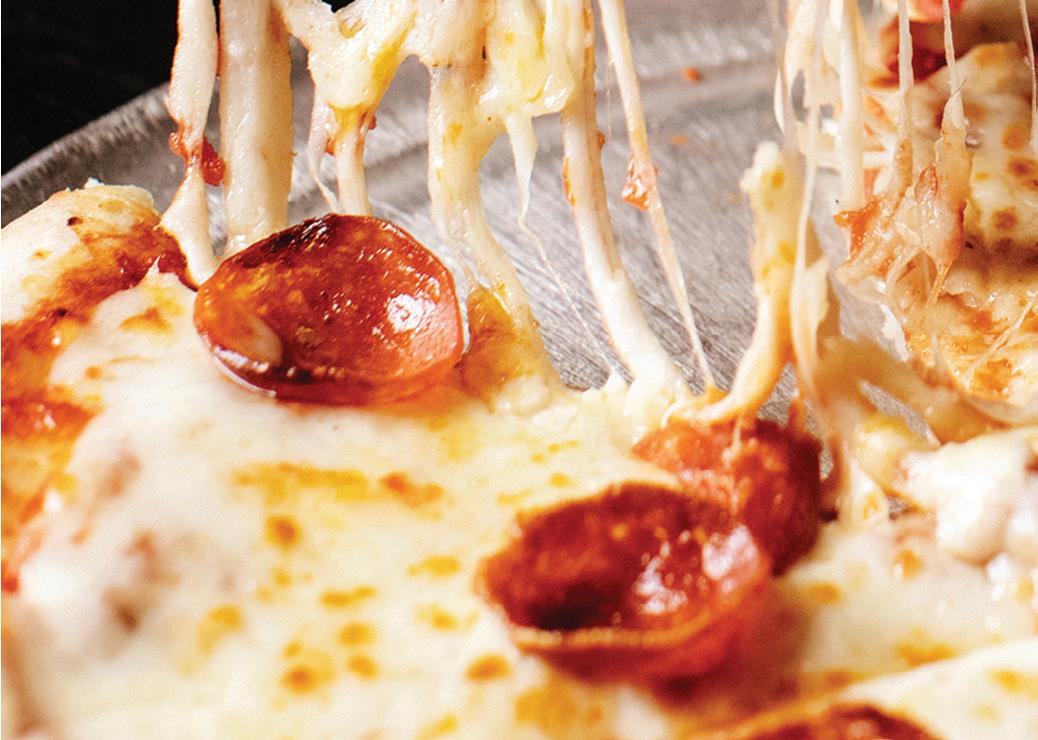

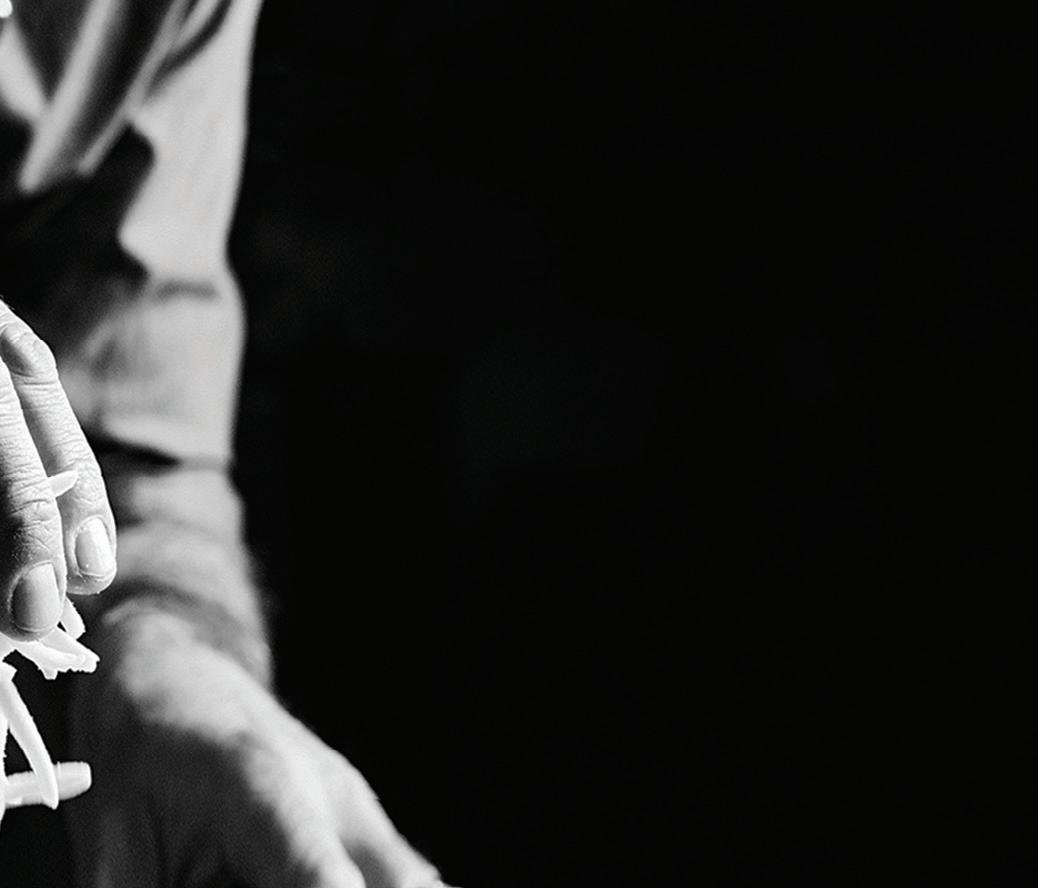
When crafting an unforgettable pizza, you’ll find that you need more than the typical ingredients. Choosing Bacio Exceptional Italian Pizza Cheese means you get a distinctly rich and creamy taste as well as an enduring relationship—the kind that turns partners into family.
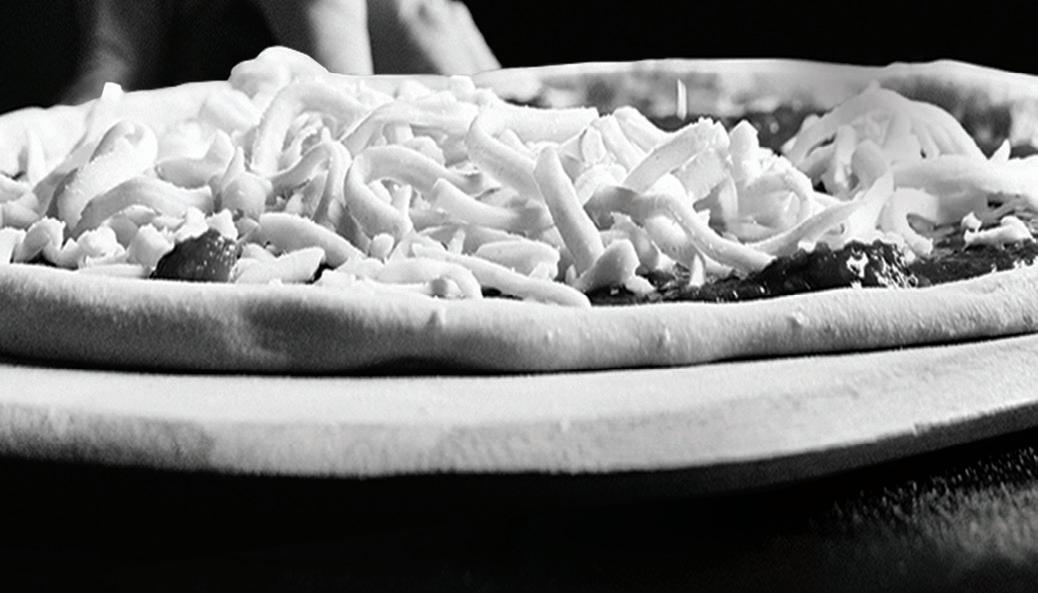



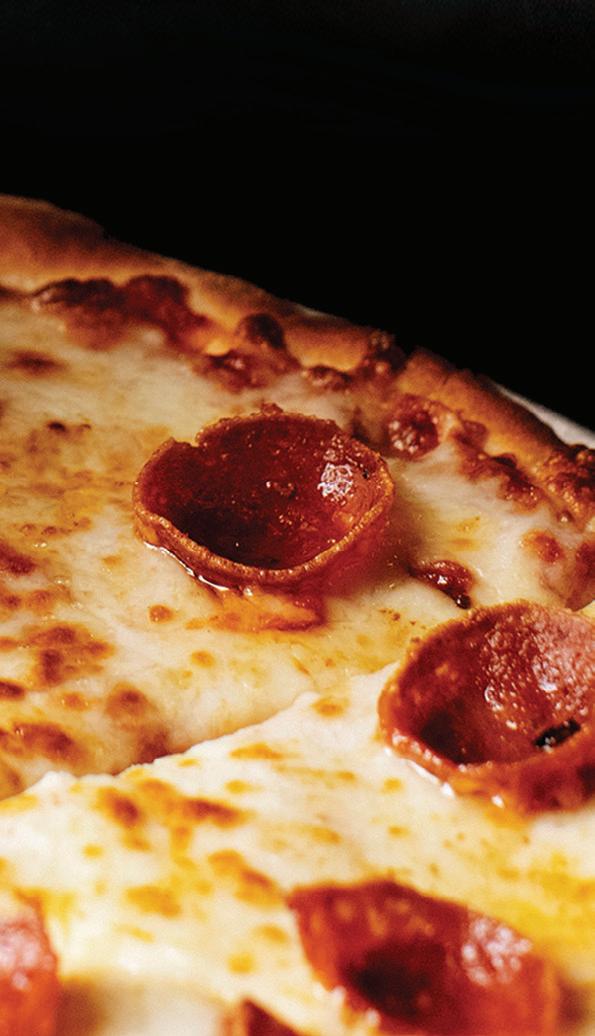

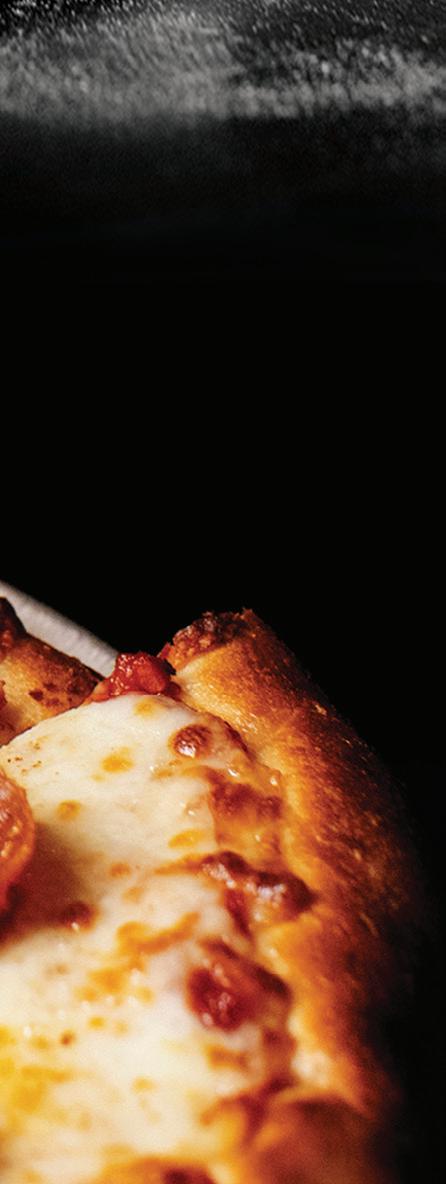

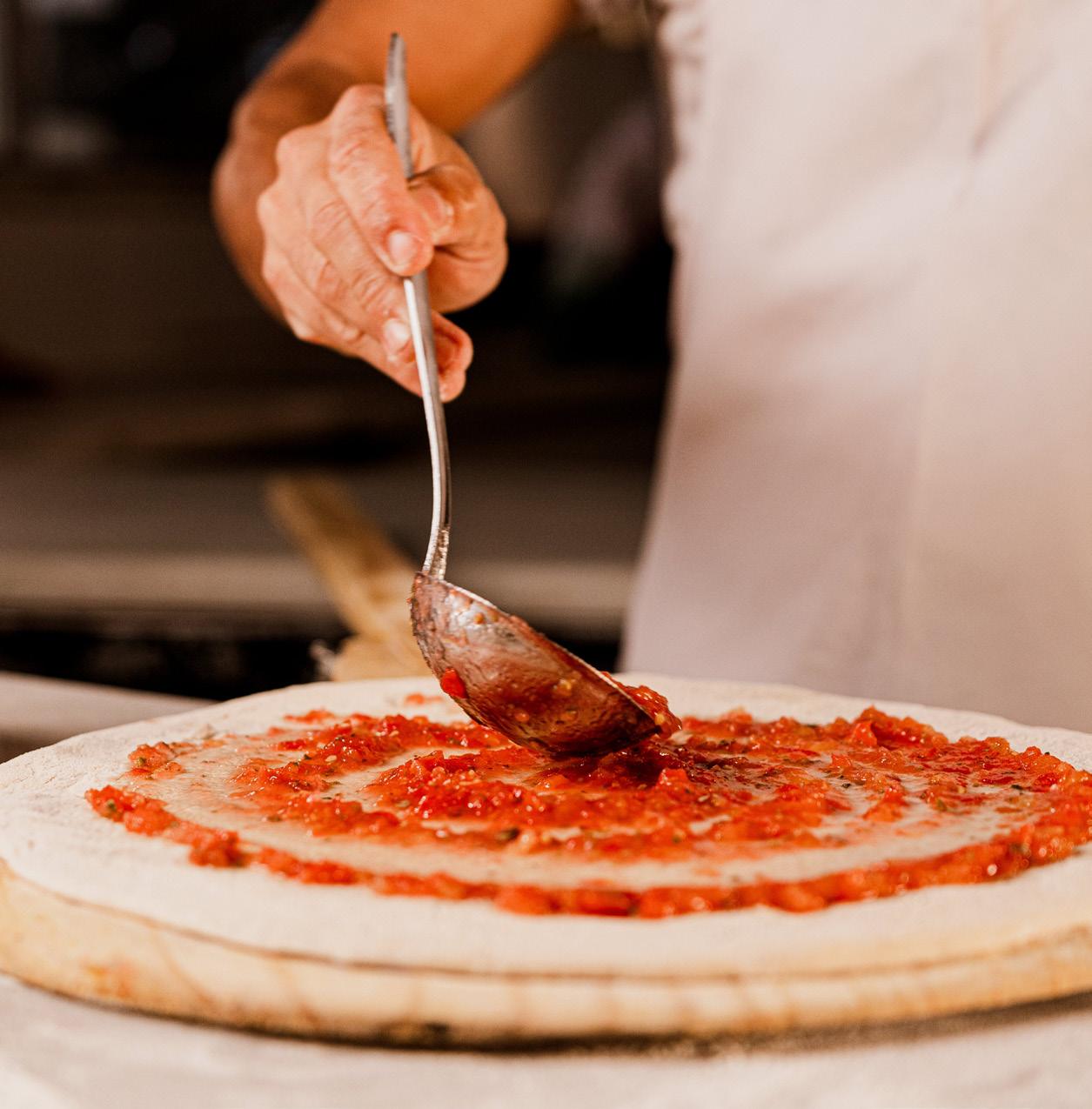
I invite you to join us on this exciting venture as we embark on a journey to elevate and enrich the world of pizza operations.
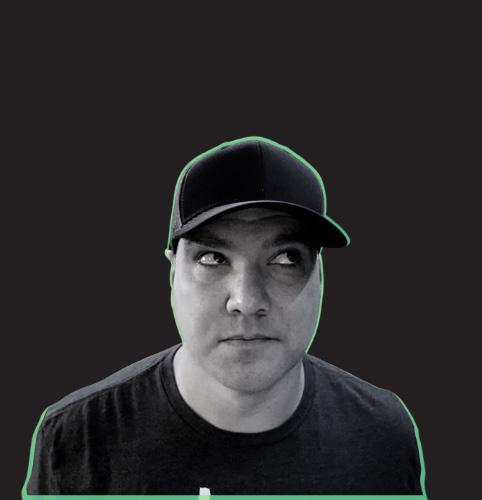
I am thrilled to introduce SPM Magazine! I’m thrilled to launch my latest labor of love in the name of pizza.

SPM Magazine’s goal is to provide valuable content specifically tailored for pizza operators, echoing my core values I’ve prioritized since the launch of SPM in 2015.
What sets SPM Magazine apart from other publications is our unwavering commitment to prioritizing valueadded content before anything else. Sure, there will be advertisements, but from companies we believe in and that have the successes of entrepreneurs in their best interest. Content that helps operators make a better business for themselves will always be our goal.
We are a small but mighty team— allowing us to quickly adapt to the ever-changing needs of our industry—bringing you the content you need when you need it and when it’s relevant.
One aspect close to my heart is providing a platform for smaller pizza operators to share their experiences and insights. Inclusivity and collaboration are fundamental values in the magazine creation process. By fostering a sense of community within the industry, we aim to make SPM Magazine a space where diverse voices are heard and celebrated.
As we strive to reach a broader audience, I am enthusiastic about the potential impact SPM Magazine will have on pizza operators everywhere. The magazine is not just a publication; it's a hub for knowledge
exchange, support, and inspiration. I invite you to join us on this exciting venture as we embark on a journey to elevate and enrich the world of pizza operations.
With your support, SPM Magazine aims to become a trusted resource— providing insights, trends, and stories that resonate with pizza operators at every level. Thank you for being part of this community, and I look forward to the exciting times ahead as we collectively shape the future of SPM Magazine.
 BRUCE IRVING, CONTENT DIRECTOR
BRUCE IRVING, CONTENT DIRECTOR
03
EDITOR’S NOTE: WELCOME TO SPM MAGAZINE
05
8 DEADLY HIRING MISTAKES RESTAURANTS MAKE: A NO-NONSENSE GUIDE
How restaurateurs can transform their approach, revolutionize their team, and craft an unforgettable guest experience.
13 A SLICE OF ADVICE
Industry insiders share the best advice they've received and tidbits for newcomers.
15
LAYING THE FOUNDATION: WHY TEAM BUILDING MATTERS?
Investing in your team goes beyond traditional approaches.
18
BUILDING A PIZZA EMPIRE FROM THE GROUND UP
Zalat Pizza’s Khanh Nguyen checks in to share insights on hiring, training, team building, and marketing a successful pizzeria.
23
DON’T FEED THE (INTERNET) TROLLS
Navigating your restaurant’s online presence and how to best address potential backlash on social media.
25 HOW TO OPTIMIZE YOUR TECH-DRIVEN PIZZA CONCEPT
Dough Boy founder Erica Barrett dishes on the highs and potential lows of running a tech-driven concept.
31
MUST-TRY PIES ACCORDING TO PIZZERIA OWNERS
See what’s on the menu when these makers are on the road.
32
8 STEPS TO GROW & SCALE YOUR PIZZERIA
Creating an Expansion Blueprint for your pizzeria.
35
PASSING THE PEPPERONI: CONTINUANCE OF THE FAMILY LEGACY
You’ve become the owner of a restaurant, now what?
37
IS FRANCHISING THE PATH FOR YOU?
West Shore Pizza franchisee Tyrell Reed shares his experience and keys to success.
41
WE CAN PIZZA THAT: THE CREATURE FROM THE CRAB RANGOON
How to transform the beloved crab rangoon appetizer into a pizza.
WANT TO REPORT A NEW DEVELOPMENT AT YOUR COMPANY?
SEND THE DETAILS TO SMART PIZZA MARKETING MAGAZINE
Email: Team@smartpizzamarketing.com
Listen up, restaurateurs! This isn't your typical, sugar-coated advice column. This is a wakeup call, a battle cry for those in the trenches of the restaurant industry. You know your menu is dynamite, and your venue is stunning, but there's a lurking danger you might be ignoring–your hiring strategy.
How restaurateurs can transform their approach, revolutionize their team, and craft an unforgettable guest experience.
Begin cultivating these talents by offering training, mentorship, and growth opportunities.

In an industry where the guest experience is the holy grail, who you hire is not just important–it's everything. Your staff are the front-line warriors, the face of your brand, and the architects of your guests' experiences. A single misstep in hiring can trigger a domino effect of disaster–including but not limited to–poor service, bad reviews, and a tarnished reputation that spreads faster than wildfire.
But fear not. This guide isn't about doom and gloom. It's about arming you with the unvarnished truth and actionable strategies to avoid the hiring pitfalls that have claimed too many well-intentioned restaurants.
Let's shatter some myths. Hiring isn't just about filling a vacancy. It's not a necessary evil to rush through. It's an art and a science–a strategic element as crucial as your choice of ingredients or the design of your menu. Each new hire holds the power to elevate or degrade your guest experience. Your team can be the secret ingredient to your success or the bitter taste that turns guests away.
So, buckle up. It's time to dive into the gritty reality of the hiring landscape in the restaurant industry. We're not just talking about mistakes; we're talking about the deadly sins of hiring that can cripple your restaurant's potential. The eight fatal errors that, if not addressed, can be the difference between a thriving hotspot and a forgettable flop.
Prepare to look at your hiring process through a whole new lens. It's time to transform your approach, revolutionize your team, and craft an unforgettable guest experience. Let's begin.
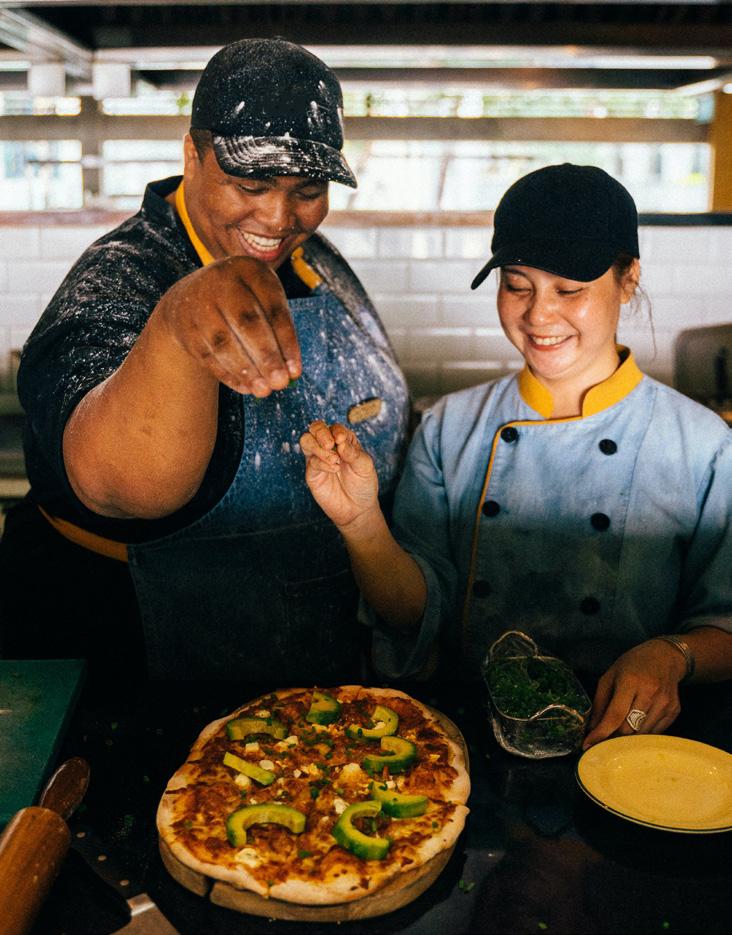
Mistake: Too many restaurant owners treat the hiring process like a kitchen during a Saturday night rush–chaotic, unorganized, and all over the place. They're so desperate to fill the gaps that they grab anyone who can hold a tray. But here's the brutal truth–this approach is a recipe for an utter disaster.
continued on next page
Cultivate a team that shares your vision, embodies your passion, and elevates your standards.
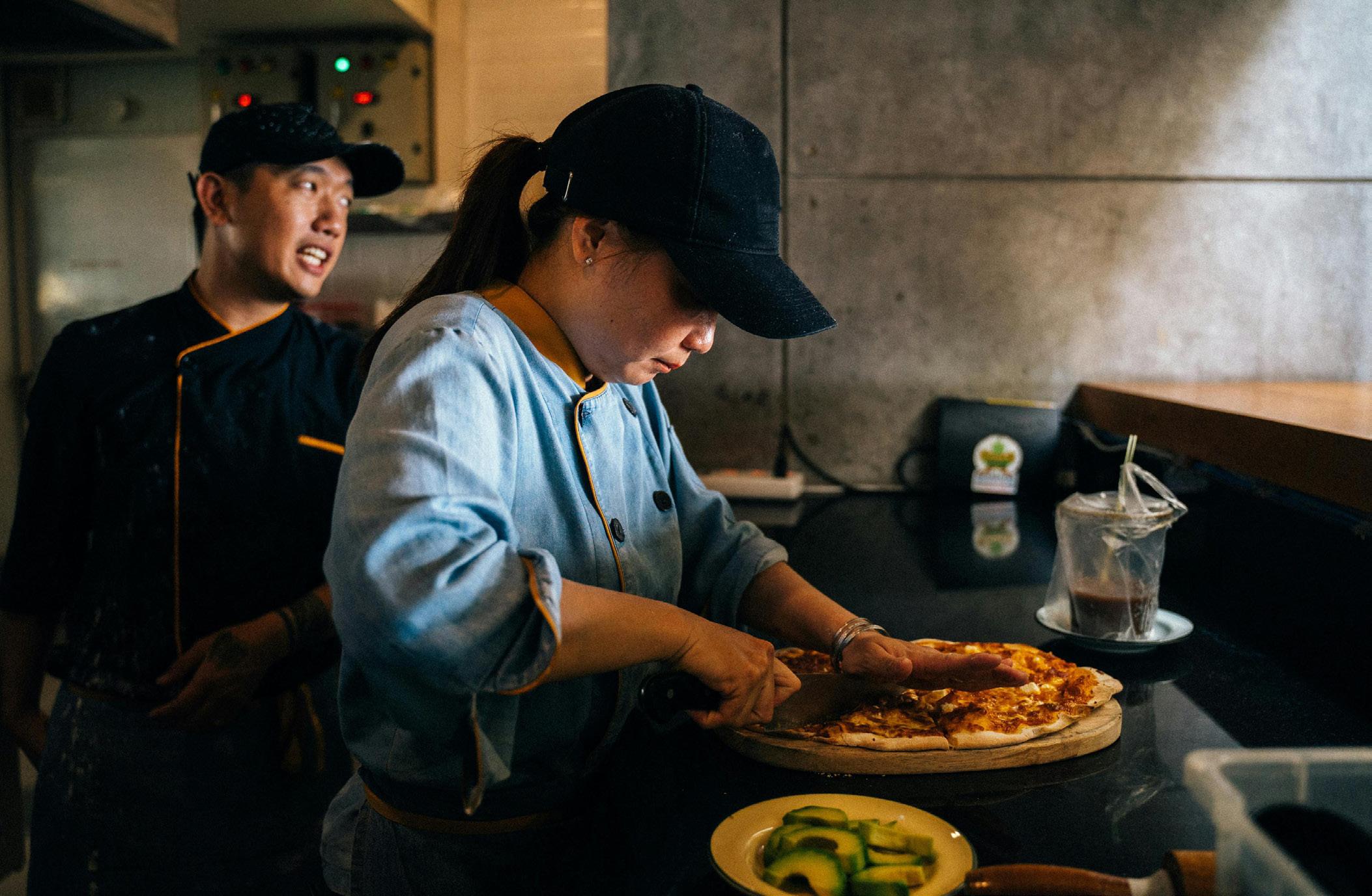
continued from previous page
Imagine a kitchen where no one knows who's on the grill or who's plating the desserts. That's what happens when you hire in chaos. You end up with a team that's as disjointed as a mismatched set of cutlery. It's not just about finding bodies to fill aprons; it's about finding the right people who can jive with your rhythm and elevate your brand.
Impact: What's the fallout? First, you end up with a team as cohesive as oil and water. There's no synergy, no unity, just a bunch of individuals clocking in and out. This disarray isn't just felt in the back of the house; it seeps out to the dining room, sticking to your guests' experiences like an unwelcome aftertaste.
Then, there's the legal side–a nightmare you want to avoid at all costs. Without a structured hiring process, you're gambling with
compliance issues, discrimination claims, and a whole host of legal landmines that can blow up your reputation and finances.
And speaking of reputation, let's talk about that tarnish. Guests aren't just there for the food; they're there for the experience. A disorganized team leads to service mishaps, longer wait times, and an atmosphere that screams, "we're not in control." In the age of social media and online reviews, a few bad experiences can spread like a grease fire, scorching your reputation beyond recognition.
Solution: So, what's the secret sauce to avoid this chaos? Implement a military-grade hiring process. Yes, you heard that right. Your hiring process should be as precise and disciplined as a Michelin-starred chef's recipe.
Start by defining the roles as clearly as the difference between
a sous chef and a line cook. Craft job descriptions that don't just list responsibilities but also spell out the character and skills needed.
When it comes to interviews, don't just wing it. Develop a standardized set of questions that allow you to probe not just the experience but also the fit. You're not just looking for someone who can cook or serve; you're looking for someone who can embody your restaurant's ethos and vibe.
And background checks? Nonnegotiable. They're the garnish on the hiring process–seemingly small but vital. They help you weed out the risky choices and ensure you're bringing in people who will add, not subtract, from your restaurant's success.
In essence, stop hiring like you're plugging holes in a sinking ship. Start hiring like you're assembling an elite team of culinary commandos, each
skilled, each fitting a specific role, all moving in unison towards one goal–delivering an exceptional guest experience.
Mistake: In the culinary world, some restaurateurs treat cultural fit like it's a garnish–nice to have but not essential. This, my friends, is like serving a steak without the seasoning – bland and a monumental error. Ignoring cultural fit is like pouring old wine into a new bottle; it just doesn't blend.
Why? Because every restaurant has its unique flavor, its own DNA. This isn't just about the theme or the cuisine; it's about the vibe, the energy, the way your team interacts. It's about how each member contributes to creating that unforgettable guest experience. When you ignore this and focus solely on skills and experience, you're setting yourself up for a disaster.
Impact: Imagine a finely tuned orchestra where one musician is off-beat. That's the impact of a poor cultural fit. It's not just a minor hiccup; it's a fundamental disruption that affects the entire symphony. In restaurant terms, this means a disjointed team, awkward interactions, and a vibe that feels as uncomfortable as a bad table arrangement.
This disharmony isn't just felt among the team; it seeps into every interaction with your guests. It can turn a buzzing restaurant into a
chaotic mess where guests feel the tension as soon as they walk in. In a world where guests are looking for experiences, not just meals, a disjointed team is the fastest recipe to turn them off.
Solution: So, how do you fix this? Start treating cultural fit like the main course, not a side dish. This means shifting your hiring focus. Sure, skills are important, but they should be on par with cultural fit. When interviewing, you need to grill for fit as intensely as you do for skill.
Dive into their values, attitudes, and motivations. Are they a team player? Do they thrive in a fastpaced environment? Do they align with your restaurant's ethos? These aren't fluffy, feel-good questions; they're critical to ensuring your team operates like a well-oiled machine.
But don't just take their word for it. Get creative. Involve your team in the hiring process. After all, they're the ones who'll be in the trenches with the new hire. Consider trial shifts or team interviews to see how potential hires interact with your current team.
In essence, hiring for cultural fit means looking beyond the resume.
It's about finding those individuals who will not just fill a role but enrich your restaurant's culture. It's about creating a team that moves in harmony, offering an experience that has guests coming back for the ambiance as much as the food.
Mistake: It's a trap many restaurateurs fall into: always scanning the horizon for new talent, while ignoring the gold mine they already have in their own establishment. It's like obsessing over a fancy new kitchen gadget while neglecting the trusty, seasoned pans that have always delivered. This oversight isn't just a missed opportunity; it's a critical blunder.
Remember, your current team members are not just staff; they are the lifeblood of your restaurant. They've been in the trenches, they know your guests, they understand your operations. When you overlook this internal talent pool for external continued on next page
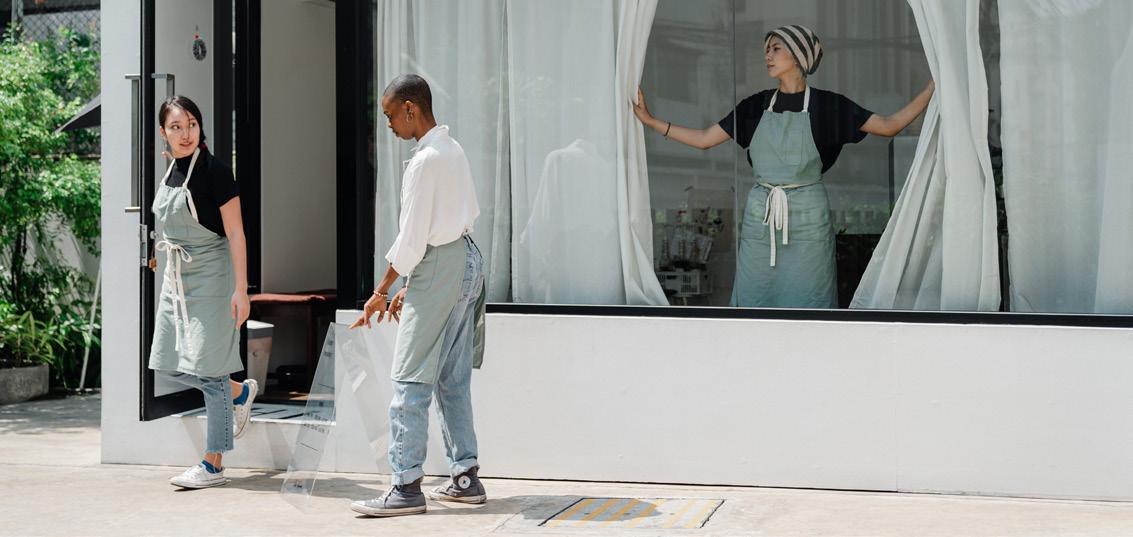
It’s about creating a team that moves in harmony, offering an experience that has guests coming back for the ambiance as much as the food.
continued from previous page
stars, you're not just missing out on potential; you're actively demoralizing your team.
Impact: What happens when your team feels overlooked? Their morale plummets faster than a soufflé in a slammed door. They feel undervalued, unrecognized, and start questioning their future in your establishment. This isn't just about hurt feelings; it's about cold, hard business impacts. A demoralized team means decreased performance, lackluster guest interactions, and ultimately, a turnover rate that'll make your head spin.
Moreover, constantly bringing in outsiders means you're perpetually starting from scratch. New hires need time to acclimate, to learn the ropes, to gel with the team. This is time and energy that could have been saved if you had simply looked inward and recognized the stars you already had.
Solution: So, how do you avoid this pitfall? Start by turning your gaze inward. Look at your team. Who are the ones always going the extra mile? Who has shown a passion for learning and growth? These are your diamonds in the rough, your internal stars waiting for a chance to shine.
Begin cultivating these talents. Offer training, mentorship, and growth opportunities. Show them that there's a path forward in your restaurant. This isn't just about retaining staff; it's about building a team of dedicated, skilled professionals who are invested in your restaurant's success.
Incorporate a culture of recognition. Celebrate achievements, acknowledge hard work, and make it clear that dedication and talent are noticed and valued. This will not only boost morale but also foster a sense of loyalty and belonging.
Remember, the next time you're looking to fill a position, don't just
automatically post a job ad. Take a moment to assess your current team. Your next great chef, manager, or sommelier might already be working for you, just waiting for the opportunity to step up to the plate.
Mistake: In the high-octane world of the restaurant industry, it's easy to get caught up in the hard skills–the slicing, dicing, and sautéing. But here's where many restaurateurs drop the ball: they undervalue soft skills, treating them like some frivolous, unnecessary garnish. This mindset is not just outdated; it's dangerously shortsighted.
Soft skills like communication, empathy, teamwork, and adaptability, are the secret ingredients that give your restaurant its soul. They turn a meal into an experience, a visit into a memory. Dismissing these

Remember, guests aren’t just there for the food; they’re there for the experience.
skills as trivial is akin to ignoring the seasoning in a dish–the result is bland and forgettable.
Impact: So, what's the fallout of overlooking these critical skills? You end up with a team that functions like a group of solo artists rather than a symphony. They may be technically proficient, but they lack harmony, cohesion, and the ability to create an atmosphere that resonates with your guests.
This lack of soft skills doesn't just erode team chemistry; it directly impacts your guests. Remember, dining out is an emotional experience. Guests may forget what they ate, but they will always remember how your team made them feel. A server who can't empathize, a chef who doesn't communicate, a manager who can't lead–these are the chinks in the armor that leave your guests feeling cold and disconnected.
Solution: So, how do you weave these soft skills into the fabric of your team? Start by recalibrating your hiring focus. Yes, technical skills are important, but they should walk hand in hand with soft skills. During interviews, probe not just for what candidates can do, but for how they do it. How do they handle stress? Can they work seamlessly in a team? Do they have that spark of empathy that ignites a memorable guest experience?
But it doesn't stop at hiring. Cultivating a culture that values and develops soft skills is key. This means training, yes, but also leading by example. Show your team that these skills are not just valued but essential. Encourage communication, foster teamwork, reward empathy, and champion adaptability.
Remember, in the restaurant business, the heart is as important as the hand. The ability to connect, to make guests feel valued and understood, is what turns a restaurant into a haven, a place where guests don't just dine but belong. So, balance the scales. Hire for attitude; train for skill. Because at the end of the day, it's not just about the meal; it's about the experience. And that experience is defined by the soft skills of your team.
Mistake: Here's a high-stakes game too many restaurateurs play: skipping the reference check. It's like picking a random bottle from the wine cellar and hoping it pairs well with the dish. You might luck out, or you might end up with a disastrous combo. Not checking references is akin to culinary Russian roulette–you're gambling with every aspect of your restaurant.
Think about it. A resume tells you what they want you to know; references tell you what you need to know. By skipping this critical step, you're flying blind, relying on gut feeling and crossed fingers. It's a risk that's as unnecessary as it is dangerous.
Impact: The stakes? Your restaurant's reputation, the team's dynamics, and, ultimately, your bottom line. Hiring without reference checks is like inviting a stranger to run your kitchen – it's a leap in the dark. You risk bringing in someone who's not just a poor fit, but potentially toxic. Someone who can turn your kitchen into a battleground, your dining room
into a cold, unwelcoming space.
And remember, in this digital age, a bad hire doesn't just upset your team; it can lead to negative reviews, social media rants, and a tarnished reputation that spreads faster than news of a secret menu.
Solution: The fix is simple yet nonnegotiable–do your homework. When it comes to reference checks, there are no shortcuts. Make those calls, ask the tough questions, and listen not just for what's said, but for what's left unsaid. You're not just verifying facts; you're sniffing out red flags.
And don’t just stick to the script. Dive deeper. How did they handle stress? What's their teamwork track record? How do they deal with conflict? These insights are like the secret ingredients that can turn a good hire into a great one.
Think of it as sourcing your ingredients. You wouldn’t put something on the plate without knowing its origin and quality. Treat your potential hires the same way. A little due diligence can be the difference between a superstar who elevates your guest experience and a supernova who burns brightly but destructively.
Don’t roll the dice with your hires. A reference check might seem like a small step, but it’s as crucial as tasting a dish before it leaves the kitchen. It’s the difference between a gamble and a guarantee, a risk and a reward. Do it diligently, and watch as your team transforms into a lineup of superstars, each contributing to the unforgettable symphony of your guest experience.
continued on next page
continued from previous page
Mistake: Here's a scenario that's all too common in the culinary world: a new hire comes in, fired up and ready to go, only to find themselves lost in a maze of unclear expectations and undefined roles. It's like being handed a recipe without measurements or instructions–frustrating, confusing, and ultimately disastrous. This lack of clarity isn't just a minor oversight; it's a silent killer that can suffocate your restaurant's efficiency and morale.
When roles and expectations are as murky as a poorly made bisque, it leaves your team guessing, improvising, and often stumbling. It's not just about knowing their tasks; it's about understanding their place in the larger picture of your restaurant's success.
Impact: The impact of this vagueness can be as subtle as it is devastating. In the kitchen, it leads to missteps, wasted ingredients, and inconsistent dishes. In the front of the house, it results in confused staff, mixed messages, and a guest experience that's as disjointed as a poorly curated tasting menu.
This chaos doesn't stay hidden in the kitchen or the back office; it spills out onto the dining floor. Guests can sense when a team is out of sync, and nothing ruins a meal faster than witnessing a service meltdown. And in an age where guests share everything online, one service mishap can quickly escalate into a public relations nightmare.
Solution: The antidote to this chaos? Crystal clear clarity. Treat your job roles and expectations like your menu
– precise, detailed, and unambiguous. This clarity starts right from the hiring process. Spell out what you expect in the job description, and reinforce it during the interview and training processes.
But don’t stop there. Regularly review and update these expectations. The restaurant world is dynamic; roles evolve, and so should your clarity about them. Regular team meetings, performance reviews, and open communication channels are key. They ensure everyone stays on the same page and any confusion is addressed before it turns into a problem.
Invest in training that goes beyond the basics. Equip your team with not just the 'what' but the 'why' of their roles. When they understand the impact of their work on the guest experience, they’re more likely to take ownership and excel in their roles.
In essence, steer clear of vagueness. In the fast-paced, high-stakes environment of a restaurant, clarity isn't just a luxury; it's a necessity. It's the guiding light that ensures every member of your team knows their role, understands their impact, and contributes to a seamless, unforgettable guest experience.
Mistake: It's the dinner rush, your kitchen is in the weeds, and you're down a line cook. The pressure is on, and in a desperate scramble, you hire the first applicant who walks through the door. Sound familiar? This is a trap many fall into, believing a warm
body is better than nobody. But here's the hard truth–settling for mediocrity is the ultimate sin in the restaurant world. It's like using stale ingredients in a dish and expecting it to taste gourmet.
When you hire in desperation, you're not just filling a gap in your schedule; you're potentially creating a gaping hole in your restaurant's quality and reputation. These rushed hires often lack the skills, commitment, or cultural fit needed to excel in your high-stakes environment.
Impact: The immediate impact might seem like a relief–you've got someone to cover the shift. But the long-term effects are far more damaging. These underperformers become the weak links in your team, dragging down the morale and efficiency of your entire staff. They're the burnt garlic in your sauté–tainting everything with their subpar performance.
And let's not forget the guests. They have a sixth sense for spotting a lackluster team member. Every misstep, every half-hearted service, every lack of passion gets noticed. And in today's world of instant online reviews, a few negative experiences can spread like wildfire, charring your reputation in the process.
Solution: The solution? Patience, discipline, and a refusal to compromise on quality. Yes, it's tough to turn down an immediate fix, especially when you're in a bind. But remember, short-term solutions can lead to long-term problems. Hold out for the right candidate–someone who not only has the skills but also shares your passion and fits your culture.
This may mean operating shortstaffed for a while or reorganizing your current team's responsibilities.
It's not easy, but it's a far better alternative than contaminating your team with mediocrity. Use this time to really hone in on what you need in a candidate. When you do find the right fit, the wait will seem like a small price to pay for the harmony and excellence they bring to your team.
Moreover, develop a talent pipeline. Build connections with culinary schools, set up intern programs, and create an appealing work culture that attracts top talent. Make your restaurant the place people are dying to work at, not the last resort.
In essence, never settle for mediocrity. Your restaurant is a reflection of your team, and every member plays a crucial role in crafting the guest experience. Take the time, make the effort, and be relentless in your pursuit of excellence. Your guests will taste the difference, and your reputation will thank you for it.
Mistake: In the whirlwind of the restaurant business, it's easy to forget that new hires aren't mind readers or seasoned veterans. Throwing them into the fray with a "sink or swim" attitude is like asking a new sommelier to identify wines blindfolded on their first day. It's not just unfair; it's setting them up for failure. When new team members are abandoned without proper guidance or training, you're not testing their mettle; you're handicapping their ability to succeed.

This approach is a relic of an outdated, tough-love mentality that has no place in the modern culinary world. It overlooks the basic principle that every great dish, like every great employee, requires time and careful preparation to reach its full potential.
Impact: The consequences of this neglect are far-reaching. For the new hire, it’s a fast track to frustration and disillusionment. They feel undervalued and unsupported, and more often than not, this leads to high turnover. This revolving door not only disrupts your team's dynamic but also puts a strain on your resources, constantly training new staff instead of nurturing and retaining talent.
For your existing team, it creates an environment of constant adaptation to new faces and differing skill levels. This instability can erode team morale and efficiency, turning your well-oiled machine into a clunky, unpredictable contraption.
And let's not forget the guests. They can immediately sense when a staff member is floundering. This not only affects their dining experience but also reflects poorly on your establishment. In the unforgiving world of hospitality, you rarely get a second chance to make a first impression.
Your hiring process should be as precise and disciplined as a Michelin-starred chef’s recipe.
Solution: The solution lies in a robust, comprehensive onboarding process. This means more than a quick tour of the premises and a rundown of the menu. Your onboarding process should be as meticulously crafted as your signature dish. It should include detailed training on every aspect of the job – from the nuances of your service style to the particulars of your menu and the ethos of your brand.
Invest in mentorship programs where new hires are paired with experienced team members. This not only eases the transition but also fosters a culture of teamwork and continuous learning.
Regular check-ins are crucial. This isn't micromanaging; it's providing a support system. Use these sessions to offer feedback, address concerns, and gauge their progress. Remember, a well-supported employee is an asset; one that feels abandoned is a liability.
In essence, treat your new hires as you would a rare, expensive ingredient. With the right care, attention, and preparation, they will become an integral part of the extraordinary dining experience
continued on next page
continued from previous page
you strive to offer. Your restaurant's reputation is indeed shaped by how well you train and support your team, from the seasoned chefs to the greenest of newbies.
In the high-stakes game of the pizza industry, where every pie served and every interaction matters, the real secret to success lies not just in your recipes or ambiance but in the people who bring them to life. Your team is the heartbeat of your restaurant – they are your brand, your vibe, and the architects of every guest's experience. When you understand this, you realize that hiring is not just a part of the process; it's the foundation upon which your restaurant's success is built.
The eight deadly hiring mistakes we've dissected are not just pitfalls; they are cautionary tales that illustrate a deeper truth. Avoid these errors, and you elevate your restaurant from a mere eating establishment to a guest experience powerhouse, a place where every visit is a performance, every meal a masterpiece.
Remember, every person you hire is a brushstroke in the larger picture of your restaurant's story. They are the guest experience warriors at the front lines, turning every service into a battle won for loyalty, satisfaction, and rave reviews. Their skills, attitude, and fit shape the narrative of your brand in the eyes of those who matter most–your guests.
So, as you go forth in the quest for pizza greatness, keep these lessons close to heart. Hire not in haste but with precision and foresight. Cultivate a team that shares your
vision, embodies your passion, and elevates your standards. Train them not just to perform tasks, but to understand and contribute to the grander vision of your restaurant.
In doing so, you’re doing more than just filling positions. You’re building a legacy, a team of passionate professionals who will carry your flag and champion your cause. With each carefully chosen and nurtured team member, you're not just running a restaurant; you're orchestrating an experience that resonates, delights, and keeps guests coming back for more.
This is the savage truth in the world of restaurants: your team is your greatest asset and your most potent marketing tool. They are the secret ingredient in the recipe for success. Choose them wisely, treat them well, and together, you will conquer the culinary world, one satisfied guest at a time.

Donald Burns, The Restaurant Coach™, a no-nonsense industry powerhouse. Renowned as one of the "Definitive Restaurant Experts to Follow'' and a key figure among the "23 Inspiring Hospitality Experts to Follow on X," he's your blunt instrument for taking restaurants from mediocrity to magnificence. As a former USAF Pararescueman and an Executive Chef with Wolfgang Puck, he's not here to serve just good advice; he's the kick in the ass you need to supercharge your restaurant and life. With credentials like Certified Warrior Trainer, Executive Coach, NLP Practitioner, and the Amazon Best-Selling author of the Your Restaurant Sucks Trilogy. His latest book, Savage Restaurant Success, is a #1 Amazon Best Seller. Burns is the secret weapon used by over 2800 independent restaurants around the globe to make more while working less IN their business.
Smart Pizza Marketing Magazine was created to inspire, educate and shine a light on entrepreneurs making waves in the pizza industry. What better way to foster community than with an advice swap?
Below, the featured restaurateurs in this issue share either one piece of advice they’ve received that they have carried with them throughout their career or advice they’d give someone new to the pizza business.
Bruce Irving (founder, Smart Pizza Marketing): Start small. One of the best things you can do when you start your business is to start as lean as you can. It’s a lot easier to manage and train staff to make a few things versus hundreds. I’ve seen it so many times. People open a pizzeria and have a giant menu and it becomes a nightmare all around. It’s much easier to add a menu item once you’re up and running smoothly than it is to take something off the menu once you’ve started. Start small, master what you have then add if needed.
Erica Barrett (founder, Dough Boy Pizza Co.): The one piece of advice that I give to anyone that’s in the pizza business it’s just the same things that I tell my franchisees on a day-to-day basis is we want a consistent product a great product and agree you know
a great tasting product I think that’s very important because pizza is already It’s already sells itself the world loves pizza it’s not you know one group of people that love pizza is not a specialty food. It is something that everybody loves in the world so we have a consistent product and a great tasting product that we’re going to win in the pizza game.
Khanh Nguyen (founder and CEO, Zalat Pizza): The advice that I was given from an old hand in the first few months of opening my first location, as I was lamenting the fact that I had chosen a bad location was “many restaurant owners get lucky with their first location and they think they know what they are doing, only to crash and burn when they open their next locations. Know that if you can make it out of a bad location, you will have learned the lessons you needed to learn to be successful in this business.”
Ric Gruber Jr. (CEO, Billy Bricks Restaurant Group LLC): That it's never too late to chase your dreams and to make one come true you need to block out the noise from those who are sitting on the bench or the sidelines. Also, to be innovative, creative, and relevant for the long haul, you need to be flexible and know the difference between fads and a marketplace that is changing.

Bruce Irving shares, “Start small, master what you have then add if needed.”
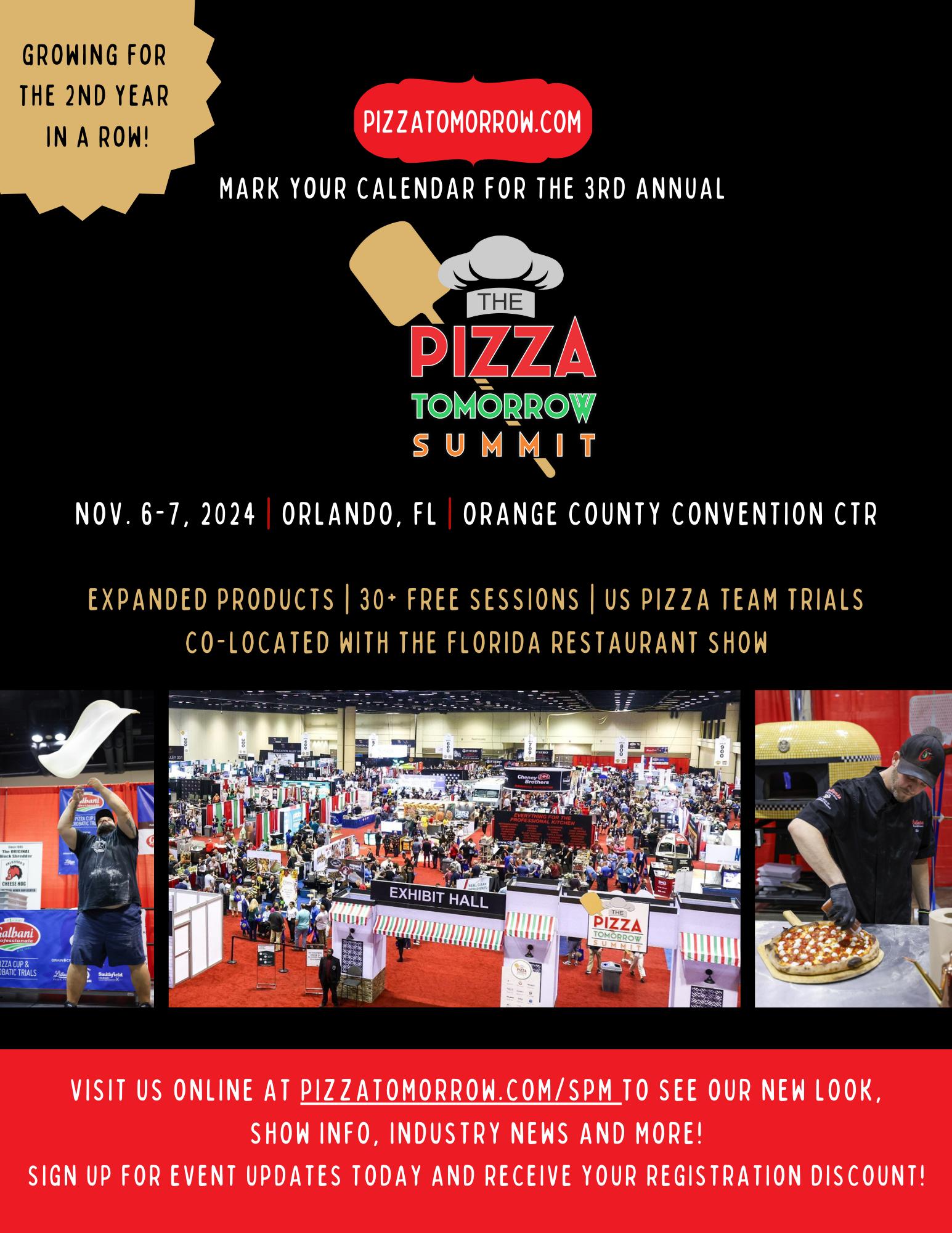
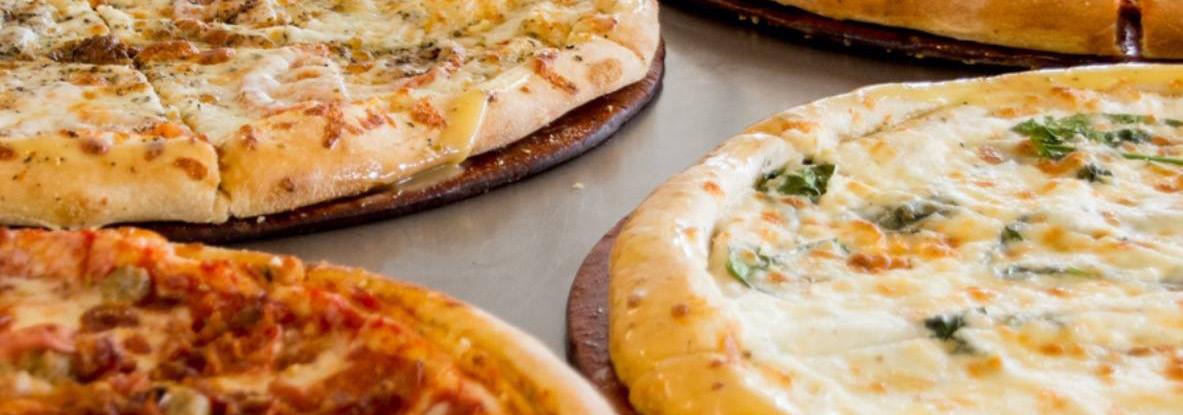
In the world of managing your pizzeria, team building is an art that requires careful cultivation.

The experience of the customer will never exceed the experience of the team. I’ve used this quote in almost every single presentation I’ve done since I myself saw it in a presentation several years ago. I love it because it completely sums up the importance of team building. I mean who doesn’t want happy and engaged customers? I know I do. There’s no secret to why a certain chicken brand has been #1 in customer satisfaction ratinga for nine consecutive years.
Is your team that excited to serve your guests?
If the answer is no, then I would then ask if you as their leader are serving your team as happily as you want them to serve your guests?
I go back to the quote.
“The experience of the customer will never exceed the experience of the team.”
Now serving as the cornerstone philosophy in my leadership style, it implies that a happy and wellsupported team translates to
satisfied customers, who, in turn, become loyal patrons. The challenge for leaders is to create an environment that nurtures and empowers the team to provide outstanding service.
Remember a happy leader serves a happy team. A happy team serves happy guests. Happy guests reward us with repeat business.

By understanding the cost versus benefit of routines, businesses can optimize their operations, ultimately resulting in increased productivity and free time.
The costs associated with replacing team members are staggering. The National Restaurant Association (NRA)b estimates that the average restaurant loses over $150,000 annually just from staff turnover. Studiesc show that replacing a full-time team member on average will cost a restaurant $5,864. Emphasizing the importance of investing in the development of existing team members. The NRA also states that nearly 80% of restaurant
managers started at the entry level. Reinforcing the idea that your next great leader might already be on your team. Identifying potential leaders within the team and providing them with opportunities for growth can significantly reduce turnover costs.
Investing in your team goes beyond traditional approaches. It’s not just about team building activities; it involves creating an atmosphere where team members feel valued and appreciated. This includes
continued on next page
ahttps://theacsi.org/news-and-resources/press-releases/2023/06/27/press-release-restaurant-study-2022-2023/ bhttps://www.notch.financial/blog/restaurant-turnover-rate#:~:text=The%20National%20Restaurant%20Association%20estimates,%24176%20in%20 pre%2Ddeparture%20costs
chttps://www.therail.media/stories/2016/3/17/hidden-costs-restaurant-staff-turnover
continued from previous page
physical aspects such as maintaining a pleasant working environment, replacing broken equipment, or simply ensuring the comfort of the team.
Investing in the team also requires you to take the time to really understand what your team actually needs. As the workforce continues to get younger the needs are changing. Yes, senior managers still love a good 401k plan and healthcare optionsd. However, our newer folks are more interested in flexible schedules and paid time off. Team members often seek development of on and offthe-job skills, emotional intelligence training, and simply the assurance that their voices are being heard. Integrating training and activities that improve communication and social skills pay huge dividends to your team. Just as creating avenues for open communication strengthens connections.
There’s a team building exercise that I love to use in group settings. I ask for volunteers then hand them a pencil and paper. Once everyone has their supplies, I ask the group to draw a rhino. This exercise is fun and unique. I use it to demonstrate the importance of hands-on leadership as the goal is for everyone to draw their rhino the exact same way. As you can imagine they start off pretty funny and by the end we have some fairly decent rhino drawings. The exercise conveys the idea that leaders should work shoulder-to-shoulder with their teams, guiding them toward a shared goal. The process of drawing the rhino symbolizes the leader’s role in guiding the team to consistency and success.
To master the art of team building,
leaders should continuously develop three key skills:
Mindset, Routine, and Communication.
Mindset: Striking a balance between fixed and growth mindsets is crucial. Embracing challenges, persisting through obstacles, and viewing efforts as fruitful contribute to a growth mindset. Leaders should encourage positivity, celebrate small victories, and make interactions about more than just the job.
I use the rhino drawing exercise to demonstrate the importance of hands-on leadership as the goal is for everyone to draw their rhino the exact same way.

Routine: Efficient routines are the backbone of a successful pizzeria. Leaders must focus on simplifying processes, making them teachable and repeatable. By understanding the cost versus benefit of routines, businesses can optimize their operations, ultimately resulting in increased productivity and free time.
Communication: Effective communication is the linchpin of holding a team together. Leaders need to bridge the gap between information sent and received. Clear, consistent, and diverse communication methods, such as combining emails with a follow-up text, or in-person discussion help to ensure every team member is on the same page.
In the world of managing your pizzeria, team building is an art that requires careful cultivation. By investing in the team, identifying potential, and nurturing open communication, leaders can create an environment where success becomes a shared journey. Exercises like the rhino drawing beautifully illustrate the collaborative nature of effective leadership, highlighting that true leaders create future leaders. As the industry evolves, mastering the art of team building will remain a key ingredient for the sustained success of your pizzeria.
dhttps://business.bofa.com/en-us/content/restaurant-industry-report/employment-trends-statistics.html
Tyrell Reed is a franchise executive and multi-unit franchise owner. Over the last 20 years Reed has seen his career blossom from dish washer to multi-unit franchise owner. Gathering a wealth of experience at every position along the way. Reed has served in senior leadership roles with multiple brands including Westshore Pizza, Fuzzy’s Taco Shop, Checkers/Rally’s & Moe’s Southwestern Grill.
An expert in management training & operations, guest service, team building, and business development. With a background in project management and experience in operations, Reed has provided key support for over 100 new restaurant openings.
Reed has been featured in national and international industry publications. In 2018, he was honored to serve as a panelist and speaker at the annual International Franchise Association convention.
When not busy operating three brands across four states, Reed and his family enjoy spending time on the beach, working in the garden, listening to an audiobook, or watching a good movie.

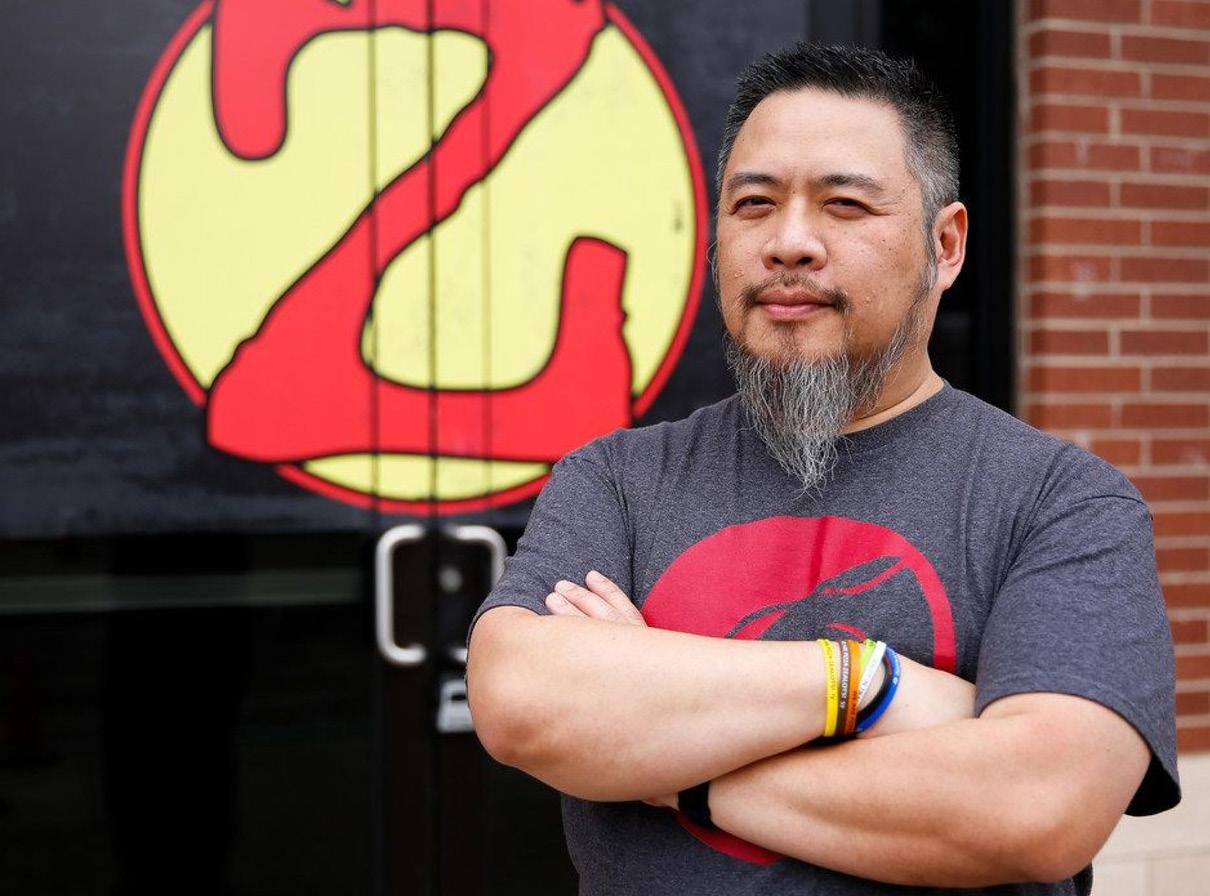
Zalat Pizza’s Khanh Nguyen checks in to share insights on hiring, training, team building, and marketing a successful pizzeria
So you want to open a pizzeria. You’ve recipe tested, you’ve locked down a storefront or food hall stall, and now you’re ready to put a crew together— but where do you start?
Whether you’re starting from scratch or are in the beginning steps of your journey as a restaurateur, industry insights from an insider who is battle tested can save you from common beginner mistakes. That’s why we
tapped Zalat Pizza founder and CEO Khanh Nguyen to share his best practices for building a pizza empire from scratch.
The Dallas-based concept made its debut in 2015 as a ghost kitchen. The brand currently boasts 32 locations spread throughout Dallas-Fort Worth, Houston and Austin. Nguyen prides himself on running his brand with an employee-first mindset. Zalat Pizza offers all employees full benefits, including health insurance, a 401(k) plan and even offers stock options.
The following interview digs into hiring, training, team building and marketing. Nguyen even discusses Zalat’s crowdfunding efforts and how offering his team company stock options cultivated a more dedicated and motivated workforce.
SPM: From recipe creation to front and back of house work, you’ve integrated yourself into every aspect of the restaurant business. Can you share your MOD for hiring?
Khanh Nguyen [KN]: As the CEO of Zalat Pizza, known as Morpheus within our Zalat family, our hiring MOD is deeply intertwined with our mission and culture. We're not just making pizzas; we're revolutionizing the takeout experience while nurturing a family of passionate individuals who have extreme GAS Factor “Give a Sh*t Factor.” Our hiring process starts with finding individuals who resonate with our missions—making the best takeout pizzas in the universe, making customers for life, and making our frontline workers wealthy through
employee stock options. We look for candidates who are genuinely excited about these goals. The GAS Factor is crucial. We seek people who care deeply–about food excellence, the customer experience, and their team. It's not just about skills; it's about attitude and a commitment to excellence.
We embrace individuality with novel initiatives like our Call Sign program. Each member of our team adopts a call sign (like the Navy pilots use in Top Gun), a unique work identity that reflects their personality and individuality. This practice fosters a sense of belonging and creativity, allowing our team members to express themselves and contribute in their own unique ways. We prioritize inclusivity and offer growth opportunities. Our commitment to making our frontline workers wealthy through stock options is a testament to this. We hire people who are ambitious, not just for themselves, but for the collective success of Zalat.
SPM: You’ve hired team members off of Craigslist with little to no experience on the line. What do you look for in a ZaLat Pizza employee?
KN: In the early stages of Zalat Pizza, particularly with our first two locations in Dallas, our approach to hiring was quite different from what it is now. Initially, we used Craigslist to hire our team members. This method had its challenges, as many of the applicants had little to no experience in the restaurant industry. Unfortunately, a significant number of these hires didn't work out, largely due to their lack of experience in the restaurant industry.
Recognizing this challenge, I took an innovative step to improve our hiring process and, concurrently, contribute to the broader restaurant community in the Dallas-Fort Worth metroplex. I created a private Facebook group exclusively for restaurant workers in the area. This platform has been a game-changer for Zalat Pizza and the industry at large. The group has grown tremendously, with over 37,000 members currently, including restaurant owners, general managers, cooks, servers, and bartenders. This journey from Craigslist to our private Facebook community exemplifies our innovative spirit and commitment to finding the right people who can thrive in our unique culture and contribute to our mission of making the best pizzas and creating a positive impact in the restaurant industry.
SPM: In terms of training, what does the process look like behind the scenes? What is your advice for a restauranteur looking to build up a team member from scratch?
KN: At Zalat Pizza, we've embraced the power of technology, particularly mobile technology, for training our team. Recognizing that most restaurant workers are more inclined to use their cell phones rather than sit in front of PCs for training, we spent years searching for the right Learning Management System (LMS) that caters to this preference. Our goal was to find a platform that wasn't just an adaptation of a PC-based system, but rather one designed specifically for mobile use, tapping into the way the younger
For restaurateurs looking to build their team from scratch, my advice is to leverage technology in your training processes.
KHANH NGUYEN

generation consumes media.
We've now implemented an exceptional mobile-first LMS that's perfectly suited to our needs. This system has revolutionized the way we train our staff, making the process more accessible, efficient, and in tune with the modern lifestyle of our team members.
For other restaurateurs looking to build their team from scratch, my advice is to leverage technology in your training processes. Invest in a system that resonates with the habits and preferences of your workforce. A mobile-first approach is not just about convenience; it's about meeting your team where they are and providing them with the tools they need in a format they are most comfortable with. This approach can significantly enhance the effectiveness of your training and contribute greatly to the success of your restaurant.
SPM: What are your best practices for team building?
continued on next page
continued from previous page
KN: At Zalat Pizza, fostering a fun and inclusive culture is at the heart of our team-building practices. We believe that every team member should feel valued and have a voice in the decision-making process. To achieve this, we create an environment where open communication and collaboration are encouraged at all levels. Regular team meetings, brainstorming sessions, and open forums are integral parts of our culture. These practices not only enhance team cohesion but also foster a sense of ownership and responsibility among our staff. By actively involving everyone in various aspects of our operations, from recipe development to service enhancements, we ensure that each member feels a part of Zalat Pizza's success and future.
Furthermore, having a noble mission as our 'North Star' is pivotal in our team-building efforts. Our clear and motivating mission, particularly the aspect of making our frontline workers wealthy through stock options, serves as a powerful unifying force. It's not just about working in a pizza chain; it's about being part of a movement that values and rewards its members. This approach has proven to be incredibly effective in building a dedicated and passionate team. The mission resonates with our employees, giving them a sense of purpose and a tangible stake in the company's success. In essence, our teambuilding practices are about creating a community within Zalat Pizza
Nguyen’s advice for owners looking to expand their team is to invest in a system that resonates with the habits and preferences of your workforce.
where everyone is working towards a shared, meaningful goal, and reaping the rewards together
SPM: In regard to Zalat’s mission of Investing in People, can you share the catalyst for offering stock options to employees? What has the response been from the employees?
KN: The decision to offer stock options to our employees at Zalat Pizza is deeply rooted in my background as a former corporate and securities lawyer and my experience with tech startups, where stock options are a standard and expected benefit. In the tech industry, it's common for early employees to share in the financial success of the company. However, when I transitioned to the restaurant industry, I noticed a stark contrast.
Many restaurant chains grow from a single location to hundreds, yet the hardworking employees who contribute significantly to this growth rarely share in the financial rewards that are granted only to senior executives. This disparity struck me as profoundly unfair.
Determined to change this narrative, we introduced stock options for our employees at Zalat Pizza. This initiative is more than just a benefit; it's a fundamental part of our mission to invest in people. By offering stock options, we're not only providing a financial incentive but also fostering a sense of ownership and partnership among our team. The response from our employees has been overwhelmingly positive. They appreciate not just the potential financial gain but also the recognition of their hard work and contribution to our success. This approach
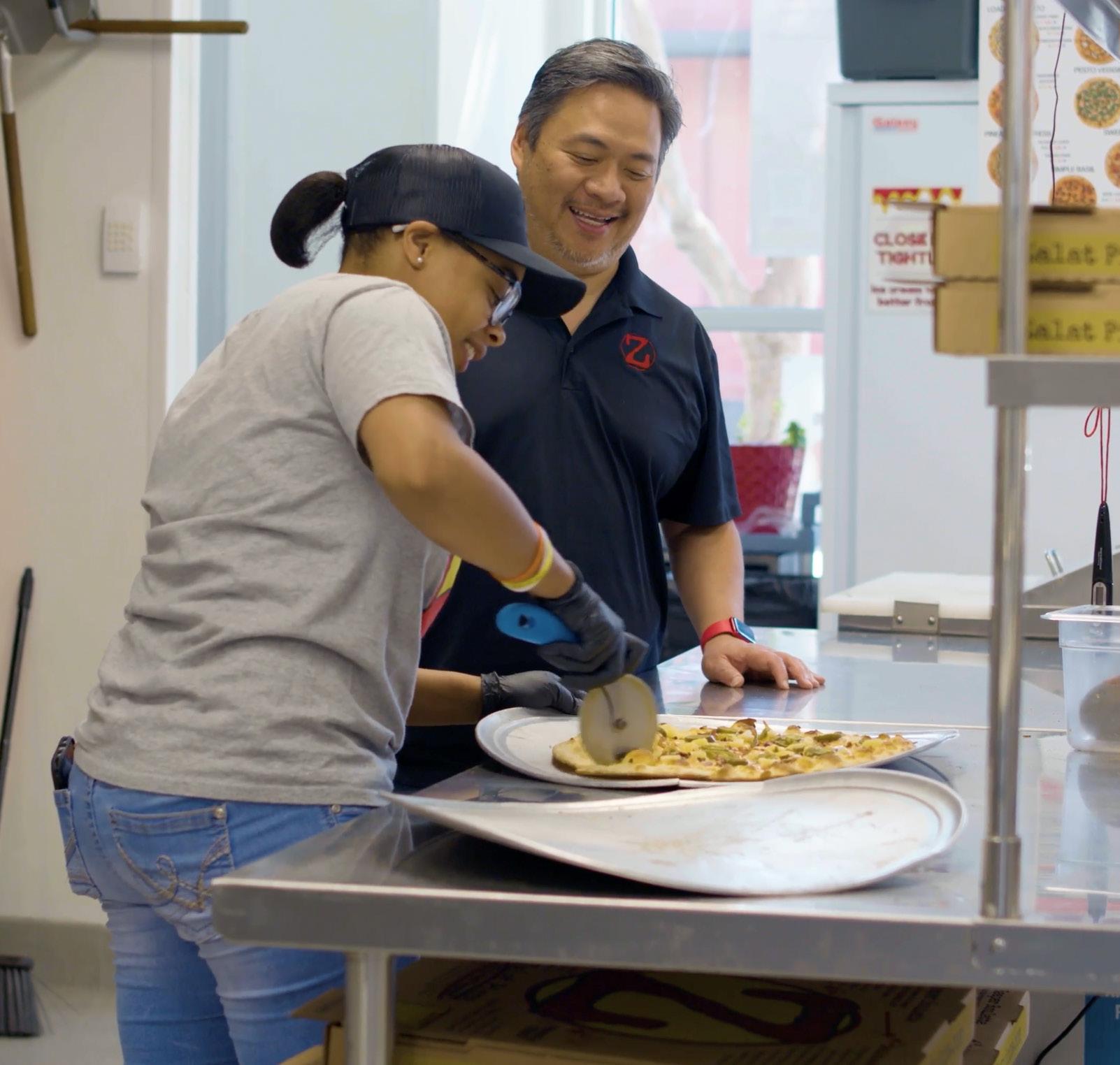
has cultivated a more dedicated and motivated workforce, as our employees see themselves as true stakeholders in Zalat Pizza's journey. It's a testament to our belief that investing in our people is the key to building a sustainable and successful business.
SPM: How could other restaurant’s integrate this option if they are already up and running? And from scratch?
KN: Unfortunately, adding stock options in an already running restaurant or restaurant group, or even when starting fresh, isn't an easy proposition, to be honest. There's a whole bunch of legal hurdles involved. It is quite a bit of time and money on hiring attorneys who know their way around SEC and IRS rules to set up an employee stock incentive plan. And don't forget about finding a solid software vendor to keep track of all the stock option details for your team. They handle the details like how long before the options vest, strike prices, and helping your crew turn those options into real shares if they want to. It's a bit of a project, but if you're up for it, it can really pay off for everyone involved.
SPM: What inspired you to go the crowdfunding route? What would you say you owe the success of the campaign to?
KN: Our decision to venture into crowdfunding was driven by a unique position we found ourselves in at Zalat Pizza. We're fortunate to have
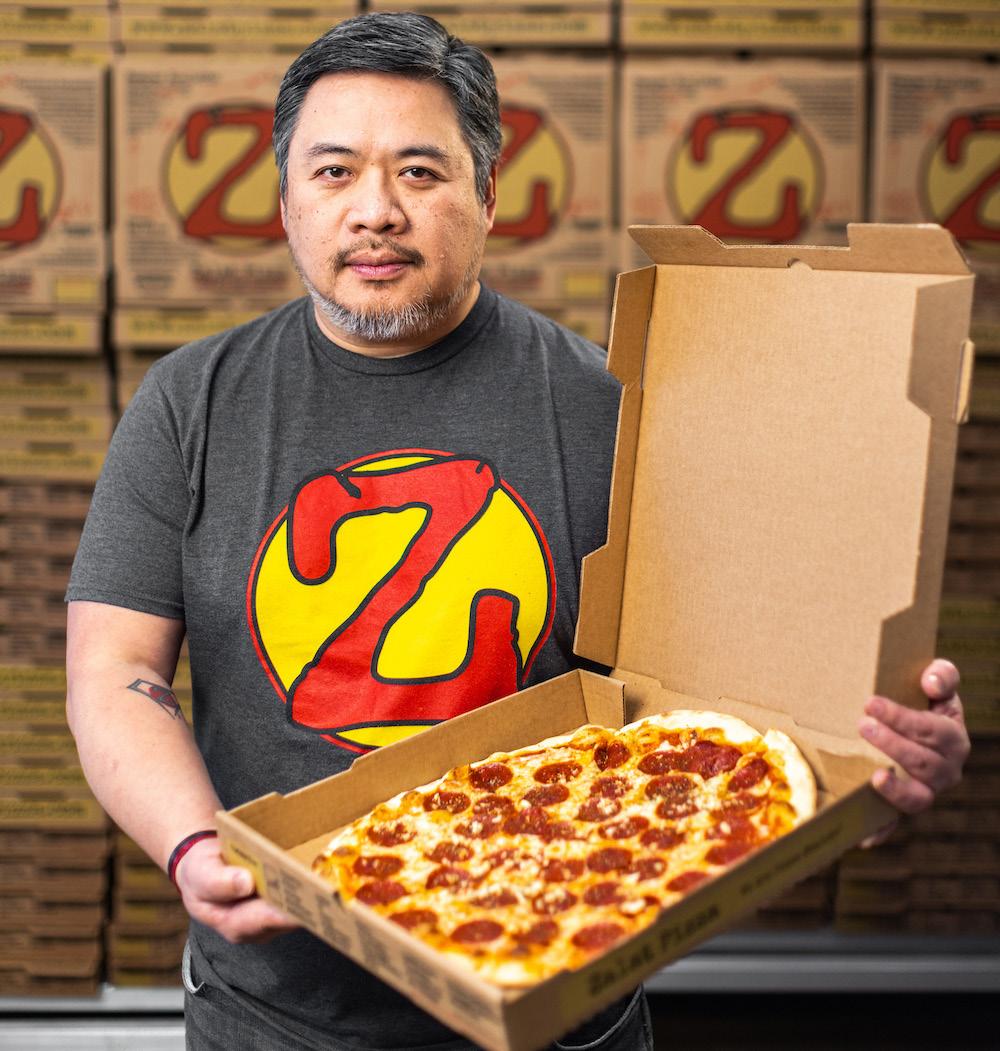
Zalat Pizza began as a ghost kitchen in 2015, and now boasts 32 locations spread throughout Dallas-Fort Worth, Houston and Austin.
a deeply loyal and enthusiastic customer base, many of whom are keenly aware of our mission to share success with our workers. This awareness sparked an idea: why not invite our customers to elevate their relationship with us? To go from being loyal patrons to becoming ‘Investomers’—a term we've recently trademarked.
This move was about aligning not just our employees but also extending this alignment to our customer base, creating a community of stakeholders who are invested in the success of Zalat Pizza. I'm thrilled to share that our campaign exceeded our expectations. We had to conclude it early due to overwhelming demand— it was completely sold out and oversubscribed. We offered $2 million
in shares, and astonishingly, over 1,700 customers chose to become Zalat Investomers. It's a testament to the strength of our community and the shared belief in our mission
SPM: What would you say or some of the key ways for marketing your brand and projects? Do they differ depending on the message? What advice would you give to a restaurant or looking to get press?
KN: When it comes to marketing your brand and various projects, my biggest piece of advice is: be ready to invest. The landscape has shifted dramatically, with most advertising budgets moving to social media. This continued on next page
continued from previous page
has created a lot of noise, making it crucial to use your ad dollars smartly. For Zalat Pizza, success in this arena comes from having experts who really know their way around digital advertising. Marketing today is incredibly tech-dependent, and you need the right partners who have deep expertise in various segments of your strategy.
SPM: Over the next two years, you are looking to expand the brand outside of the state of Texas. What does that process look like? Can you share any of the details as to what goes on behind-thescenes to make that happen?
KN: As we look to expand Zalat Pizza beyond Texas over the next two years, our focus is on setting up a robust infrastructure for franchising. Up until now, our 32 units have been 100% company-owned, but we've decided to start franchising our model. This shift comes after a thorough evaluation and conclusion that our model has reached a level where it can be replicated easily while maintaining our best-in-class pizza quality. Franchising is a strategic move that will likely propel our expansion outside of Texas, enabling us to grow at a faster rate.
However, it's crucial for us to approach this expansion conservatively. Our plan is to manage
our growth meticulously to avoid any compromise on quality, which is the cornerstone of our brand. Behind the scenes, this means a lot of planning and strategic decision-making to ensure that our franchise model upholds the standards we've set for Zalat Pizza. It involves creating detailed franchise guidelines, setting up support systems for franchisees, and developing quality control mechanisms that align with our core value of making amazing pizzas. We're committed to growing our brand without losing sight of what makes Zalat special—the exceptional quality of our pizzas.


Recognize that the most vocal critics often represent a minority, and their impact may be less significant than it initially appears.
Social media stands out as a powerful tool for promoting businesses in the world we live in today. Its extensive reach, coupled with its low cost when managed independently, makes it a powerful asset. However, in the realm of business, it's impossible to please everyone, and contentious decisions or opinions can lead to challenging situations.
I've witnessed acquaintances falling prey to false narratives on the internet, facing severe misrepresentations of themselves and their businesses amidst the chaos of comment sections. Personally, I underwent a tumultuous experience when I introduced animal products to my previously all-vegan menu. The online backlash was intense, with over 800 comments, threats to my business, staff, and family, along with 15+ scathing online reviews that had nothing to do with an actual experience at the restaurant. My inbox overflowed with criticism questioning my morals and ethics.
While a one-star Yelp review can be disheartening, this situation escalated to unprecedented levels. Initially overwhelmed, I eventually gained perspective thanks to the rational voice of my wife. Stepping back, I assessed the actual damage caused. The internet can be deceptive; what felt like a massive personal assault turned out to be a mere ripple in sales. The loudest voices represented a small fraction of the population. Social media users easily latch onto causes, expressing their opinions through comments, reviews, and posts, believing they contribute to a greater cause.
My advice to those facing potential backlash or engaging in online disputes is to take a step back. Consider disabling comments, limiting interactions through stories, and reporting inappropriate content on platforms like Yelp. Recognize that the most vocal critics often represent a minority, and their impact may be less significant than it initially appears.
Don't allow internet trolls to intimidate you. It's your business, and you have the right to operate it according to your vision. Exercise caution when responding to or fueling criticism. Even a 1 star yelp review usually doesn’t deserve your time. Dealing with irrational individuals is challenging, and engaging in arguments with them is often futile. While most people may never encounter such situations in their careers, if you do, consider the advice of "turning the other cheek.” Arguing with the internet is a losing battle every time.
Alex Koons is a 15-yearplus industry professional and pizza consultant, owner of Hot Tongue Pizza, and co-owner of Purgatory Pizza, both located in Los Angeles.
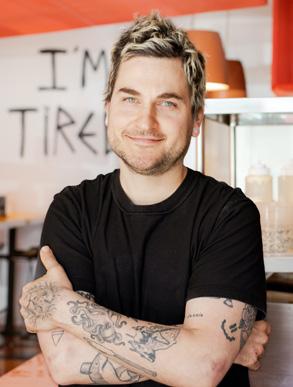
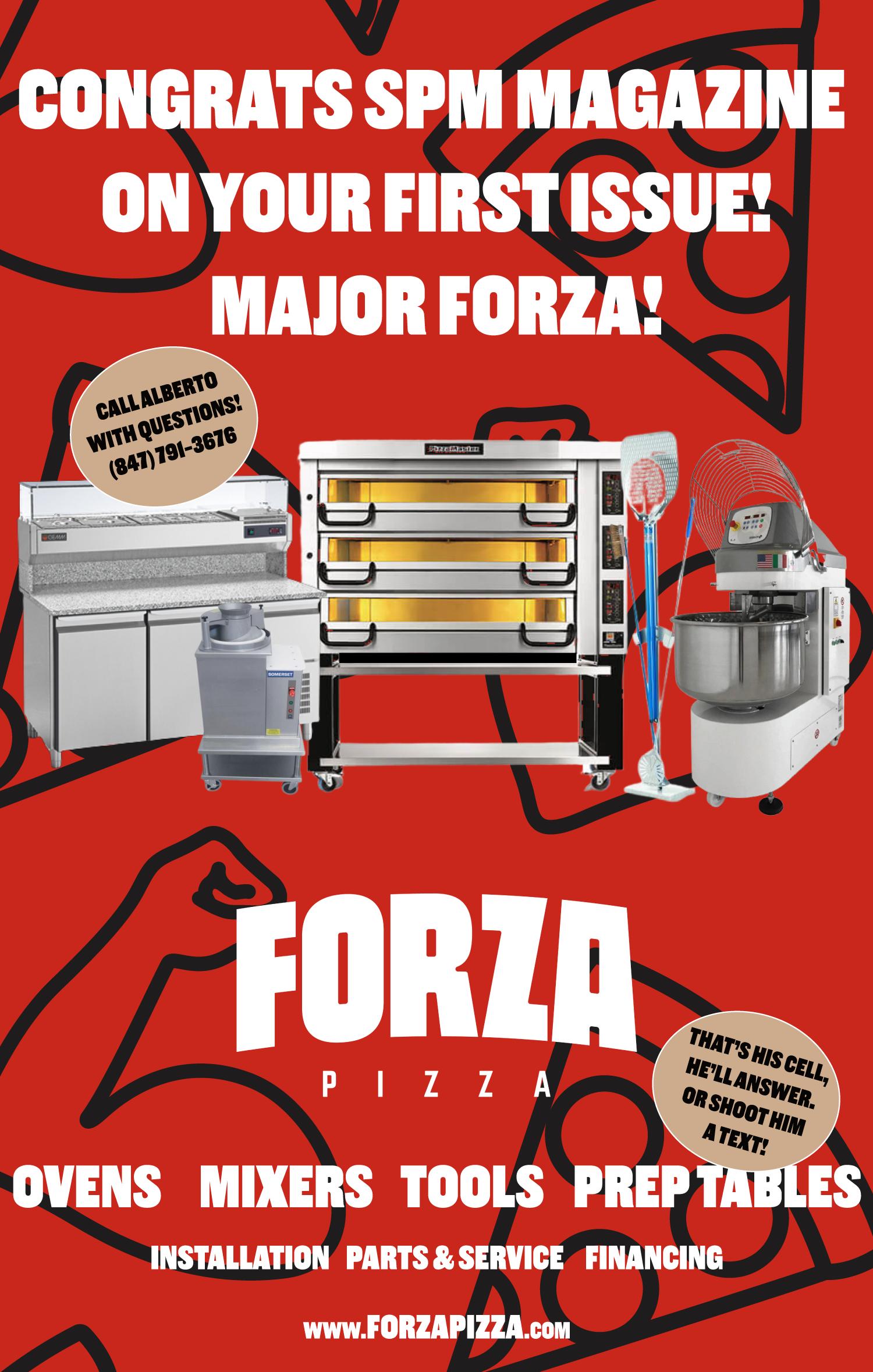

Dough Boy founder Erica Barrett dishes on the highs and potential lows of running a tech-driven concept.
Time to talk tech. Many restaurants have chosen to continue to embrace technology workarounds that were put in place during the pandemic. Whether it be utilizing QR codes for menus, ordering or bill pay, we’re beginning to see these methods be incorporated in various ways to cut costs for the restaurant with convenience in mind for the tech-savvy customer.
To further streamline operations, the industry is seeing a rise in tech-driven concepts. This route can alleviate the pressures of labor shortages to some extent, while also providing convenience and efficiency in ordering. Not to mention the plus of data-driven insights at your fingertips.
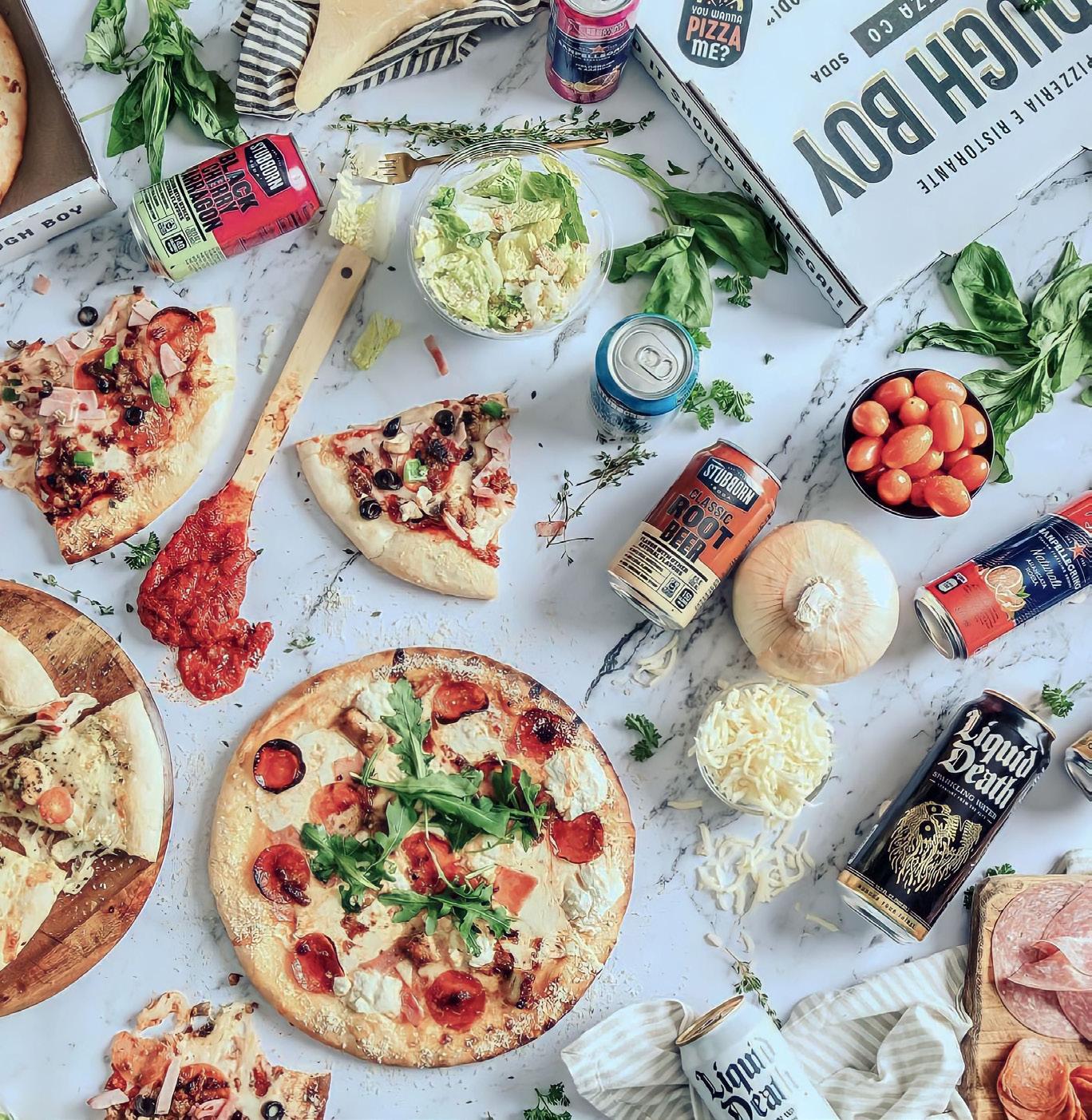
If you’re looking to launch your own concept and are considering taking the techcentric path or are interested in taking on a brand as a franchisee, this interview is catered to you.
We’ve asked Dough Boy Pizza founder Erica Barrett to shed light on the intricacies of launching a tech-driven pizza concept.
In August 2022, Barrett debuted her first Dough Boy
continued on next page
continued from previous page
Pizza location in Mobile, Alabama. Dough Boy is an innovative fast-casual restaurant focused on Neapolitan-style pies. Unlike your average fast-casual restaurant, Dough Boy operates without cashiers. Instead, customers order directly from electronic kiosks. The human element comes from the kitchen—firing Italianmade ovens and crafting pizzas with traditional toppings as well as boundary-pushing combinations, with mobsterthemed names like the Godfather of Harlem which is made up of Alfredo sauce,
shredded mozzarella, fresh garlic, chicken parmesan and topped with a parsley garnish.
In February 2023, Dough Boy secured its first operational franchisee in Decatur, Georgia. Doughboy now has three locations under its belt in less than two years.
While she is fresh to the pizza scene, Barrett is no rookie when it comes to being an entrepreneur in the food realm. She made a splash on the scene in 2010 by participating in the Lea & Perrins Shine at Dinnertime Challenge. Two years later, Barrett debuted her breakfast lifestyle brand Southern Culture Artisan Foods—which was highlighted on Oprah’s Favorite Things in 2016. The creator secured more screen time by appearing on Shark Tank (2014) followed by an appearance on CNBC’s series The Profit (2018). These accolades preceded the restaurateur’s first eatery, SOCU Southern Kitchen & Oyster Bar in 2019, just a few short years before trying her hand at the pizza business—and it proved to be as fruitful as her previous endeavors.
a tech-driven pizza concept, how to best utilize employees with this model and ways to both captivate and grow your customer base through ordering platforms, social media and online platforms.
SPM: You’re no stranger to being an entrepreneur in the food space. What made you want to dive into the pizza realm?
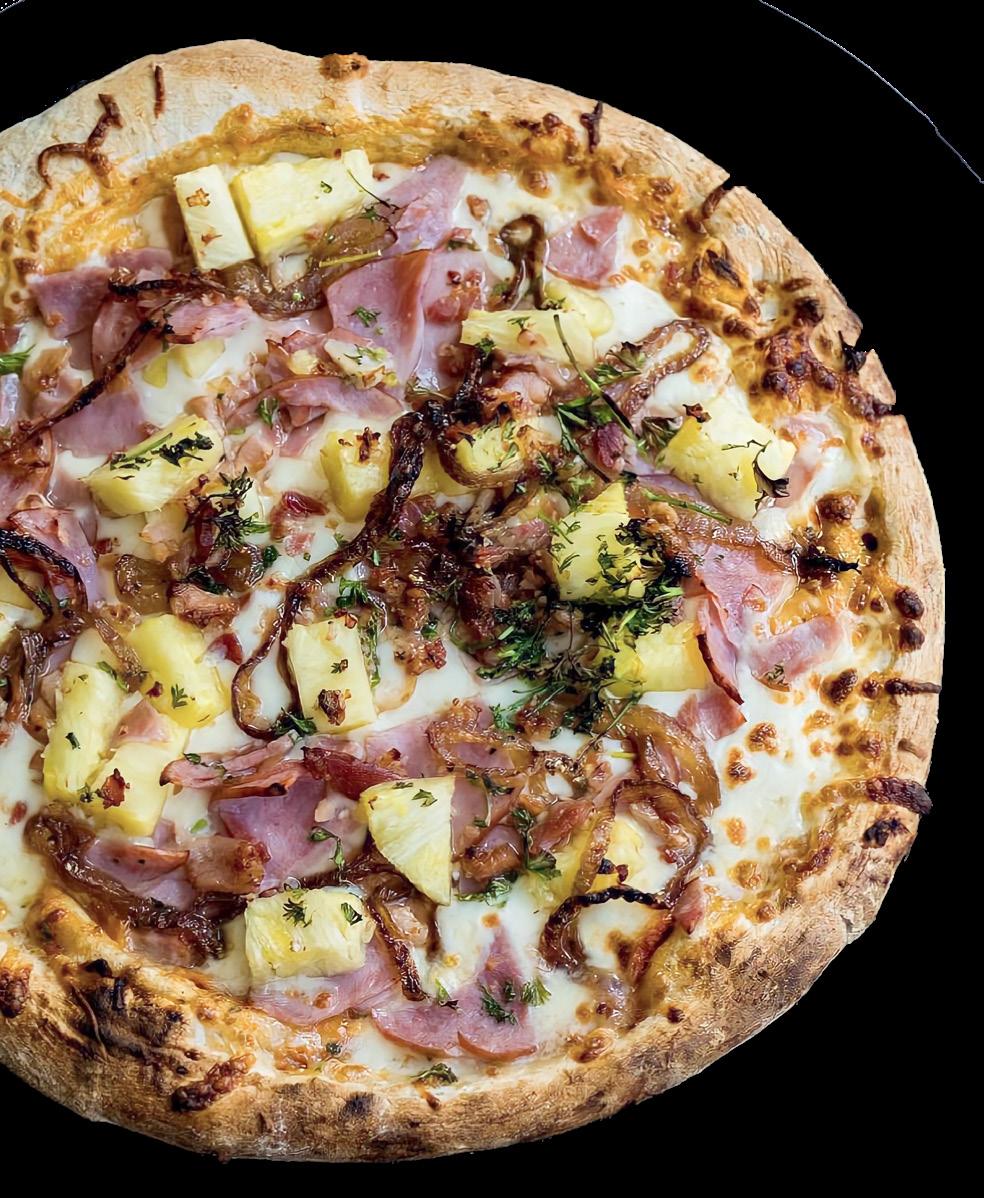
Barrett weighs in on the benefits to running
Erica Barrett [EB]: Venturing into the pizza realm was a natural step for me because of the widespread popularity of pizza and the endless possibilities for creativity and innovation within that space. I saw an opportunity to bring a unique perspective to an already beloved food item, and the potential to carve out a niche in the market with something truly special.
SPM: Can you touch on your recipe testing process? Your selection of pies have vegan crusts and many stray from “traditional” toppings. How long does a boundary-pushing ingredient pizza stay on the menu before you can gauge its success?
EB: When it comes to developing new pizza recipes with non-traditional crusts and toppings, our process involves extensive experimentation and tasting. For vegan crusts, we carefully source and test alternative ingredients to ensure both the texture and flavor meet our standards.
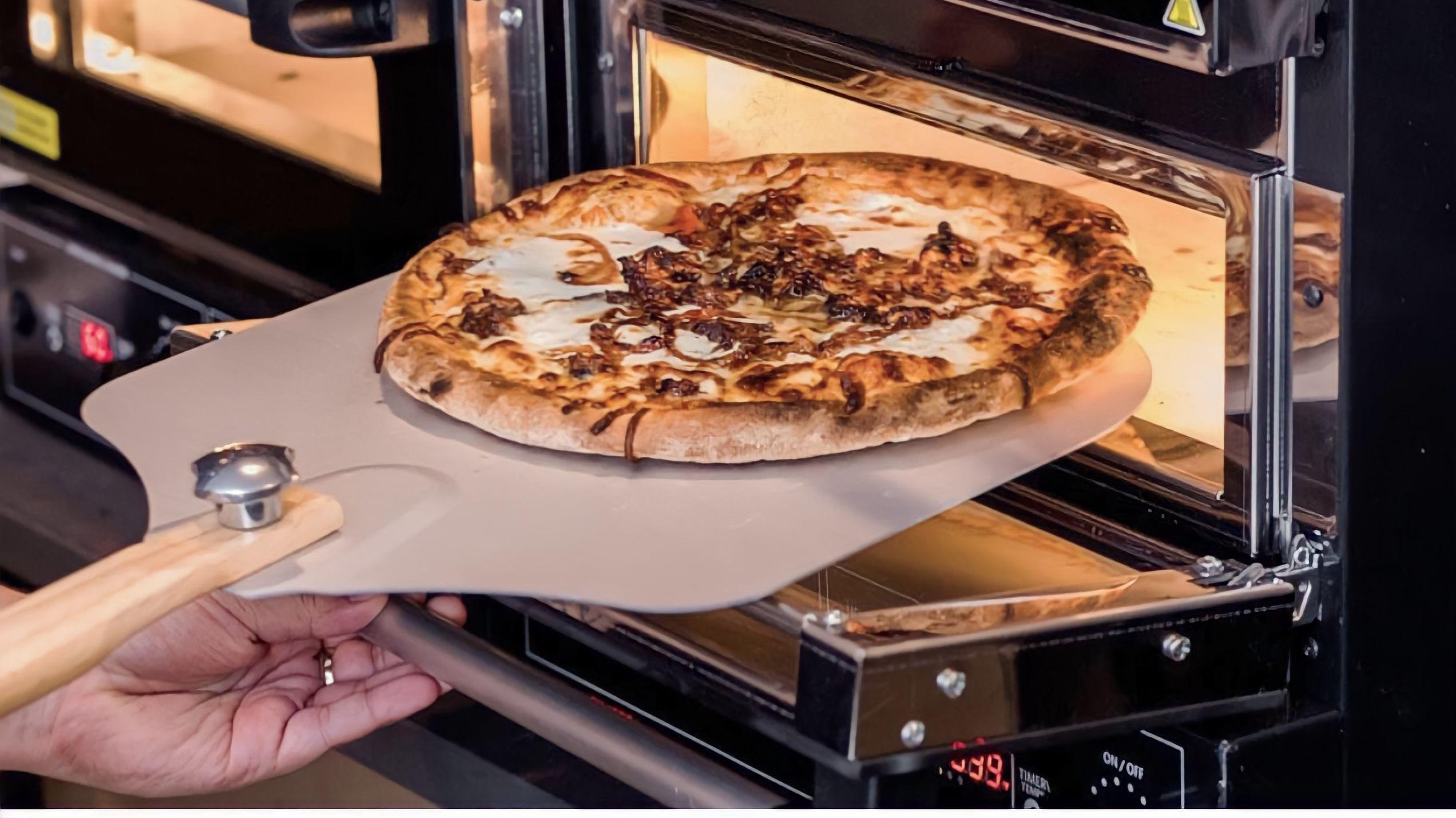
As for non-traditional toppings, it's all about balancing flavors and textures to create something unique and delicious. Our goal is to offer variety and cater to diverse dietary preferences.
As for gauging the success of a boundary-pushing pizza, we typically keep it on the menu for a certain period of time to gather feedback from customers. This helps us understand if the new creation resonates with our audience. The exact duration can vary, but we look at factors like customer feedback, sales figures, and overall reception before making decisions about whether to keep a new pizza on the menu permanently.
SPM: We know you can’t share your secret recipe, but can
you give some insight behind your calculated formula regarding your first Smart Pizza Shop?
EB: Creating a successful smart pizza shop involves several key components. Firstly, it's important to incorporate technology for online ordering, delivery optimization, and customer engagement. Utilizing data analytics to understand customer preferences and behavior can also be very beneficial. Additionally, offering unique and high-quality pizza creations while maintaining efficiency in operations is crucial. It's all about combining convenience, quality, and innovation to provide a topnotch pizza experience.
SPM: Dough Boy is a techdriven concept, what made
you choose this route?
EB: Dough Boy has chosen a tech-driven concept to enhance customer experience, streamline operations, and stay ahead in the competitive food industry. By leveraging technology, Dough Boy aims to provide efficient service, innovative ordering methods, and datadriven insights to continuously improve its offerings. This approach not only benefits the business but also ensures that customers have a seamless and convenient experience when engaging with the brand.
SPM: What are some of the benefits of using a techdriven concept?
EB: Dough Boy is committed
continued on next page
In terms of the ideal location and concept, Barrett recommends an area with a high volume of foot traffic, or situated in proximity to offices and residential areas, can be advantageous.
continued from previous page
to providing a cutting-edge experience for our customers. By integrating technology into our concept, we aim to streamline our processes, enhance customer convenience, and create a more engaging and interactive experience. Embracing technology also allows us to stay relevant in the ever-evolving digital landscape and meet the changing needs of our tech-savvy customers.
SPM: What would you say, if any, are the drawbacks to utilizing a tech-driven space versus utilizing employees?
EB: There are several potential drawbacks to relying solely on technology in a workspace, rather than utilizing employees. Some of these drawbacks might include a lack of human creativity and intuition, the potential for technological errors or breakdowns, and a reduction in personal interactions and relationships within the workplace. Additionally, technology can sometimes lead to job displacement, which can have broader societal and economic implications. It's important to find a balance between leveraging technology and utilizing the unique skills and abilities of human employees.
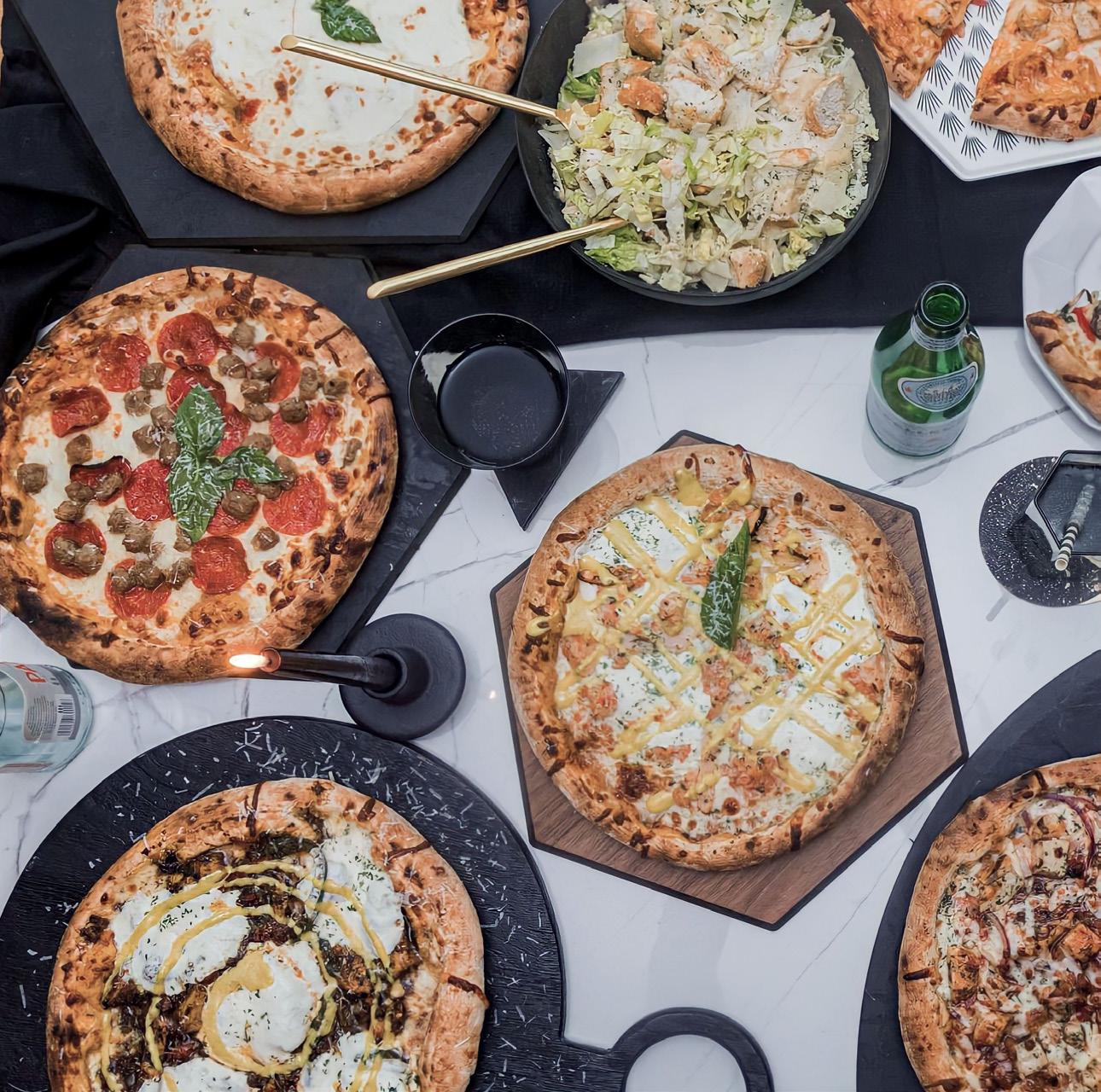
SPM: From your experience, what does the hiring process look like for a tech-driven establishment? What are you looking for in candidates?
How do you handle employee incentives for longevity? Employee growth within the company?
EB: The Dough Boy hiring process typically involves rigorous technical and culinary assessments and interviews to evaluate a candidate's skills. I often look for candidates who not only have strong technical abilities but also demonstrate problem-solving skills, creativity, adaptability, and a passion for learning and pizza making.
When it comes to handling employee incentives for longevity, I offer competitive salaries, and opportunities
for ongoing professional development, mentorship programs, and career growth paths within the company to encourage employees to stay and grow with the organization.
For employee growth within the company, Dough Boy often prioritizes continuous learning and skills development. This may include providing access to online courses, workshops, and conferences, as well as opportunities to work on challenging projects and crossfunctional teams. Managers may also have regular career development conversations with employees to understand their interests and aspirations, aligning their growth with the company's needs and opportunities.
SPM: In terms of marketing, what have you found to be
the best channels to utilize?
In the social media era, which avenue is worth the most investment as a restaurateur while promoting their brand/ product?
EB: In today's social media era, the best channels to utilize for marketing as a restaurateur are typically Facebook, Instagram, and potentially Twitter. These platforms allow you to visually showcase your menu, ambiance, and special promotions to a wide audience. Additionally, creating and maintaining a presence on review sites such as Yelp and Google My Business can also be very beneficial for promoting your brand and products. Lastly, considering the rise of visual content, investing in visually appealing content such as photos and videos can be worth more investment.
SPM: What advice would you give to an eager entrepreneur looking to open their first
pizzeria as a tech-driven concept? Any obstacles you wish you would’ve known about or unforeseen costs? Is there a specific location or concept that would make an ideal candidate?
EB: For an eager entrepreneur looking to open a tech-driven pizzeria, there are a four key pieces of advice I can offer–
Embrace Online Ordering, Delivery Partnerships & Self Ordering Solutions: In today's digital age, having an efficient online ordering system and delivery service is crucial. Investing in user-friendly equipment for ordering can make the customer experience seamless.
Use Technology to Improve Operations:
This can streamline order management, inventory tracking, and customer data management. Additionally, this
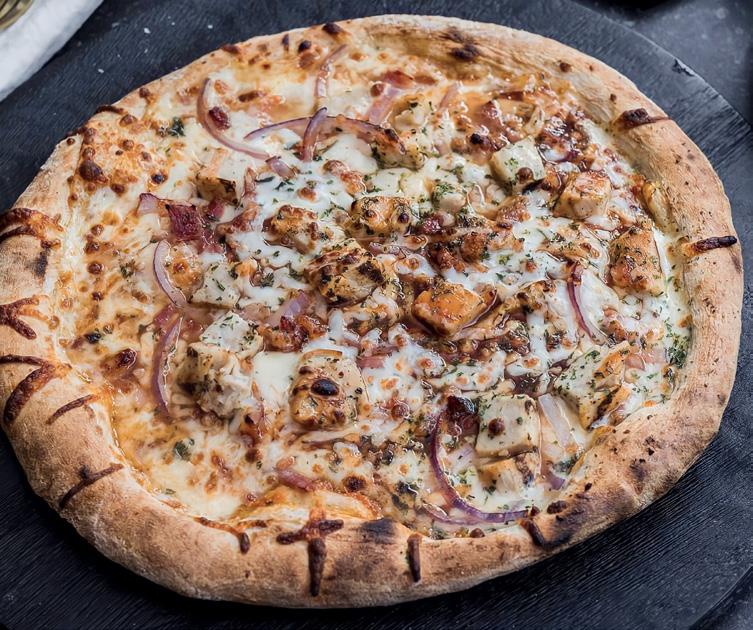
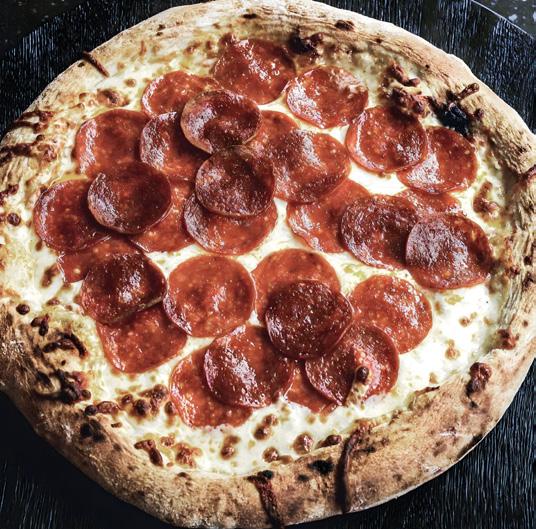
can help increase efficiency and reduce operational costs.
Leverage Social Media and Digital Marketing: Engage with customers through social media platforms and targeted digital marketing campaigns. Building a strong online presence can help attract and retain customers.
Create a Unique Customer Experience: As for potential obstacles and unforeseen costs, it's essential to consider the initial investment in technology infrastructure, ongoing maintenance and updates, as well as staff training to handle the tech-driven aspects of the business.
In terms of the ideal location and concept, an area with a high volume of foot traffic, or situated in proximity to offices and residential areas, can be advantageous. As for the concept, a pizzeria that focuses on sustainable and locally sourced ingredients, or one that offers customizable
continued on next page
Embracing technology also allows us to stay relevant in the ever-evolving digital landscape and meet the changing needs of our tech-savvy customers.
continued from previous page
pizza options using a hightech ordering system, could be appealing to the modern consumer.
Ultimately, integrating technology into a pizzeria concept can offer numerous benefits, but it's essential to carefully plan for the associated challenges and costs.
SPM: What was the catalyst for turning Dough Boy into a franchise opportunity? What does the level of involvement look like on your end?
EB: The catalyst for turning Dough Boy into a franchise opportunity was throughout my 14-year food career. I finally found a solution to a problem and that was operating restaurants in a simple and efficient way in a smart way and it really just made me
excited. I felt like the idea was too good to keep to myself .I feel with Dough Boy I am 100% confident that entrepreneurs and future franchisees and current franchisees can experience success based off this model that I worked on and created,in terms of my level of involvement with Dough Boy I work on Dough Boy every day I just worked on it this weekend with the franchisee who has two locations I just set up a meeting today with another franchisee who has two locations, so I’ll probably spend about two hours on Dough Boy daily. Of course I have other concepts, but Dough Boy is a big part of my future because it’s simple, it's easy, and it is fun to run.
SPM: What does the future look like for Dough Boy?
EB: The future of Dough Boy includes us becoming a market leader in the pizza space also
being, you know, nationally and internationally recognized as a restaurant of the future–one that incorporates technology, a changing economic climate and then also being a huge competitor in the pizza space with with recipe innovations and then also considering Gen Z so we really want to cater a lot to them. We plan on opening up thousands of outlets in stores over the next 24 months and being aggressive in that arm and also just being a brand that doesn’t follow traditional restaurant rules, but does what our customers demand for us to do.
You can find our podcast with Barrett, “How Erica Built a Pizza Empire with this Smart Pizza Shop,” on Smart Pizza Marketing’s podcast channel available to listen on Spotify or by visiting smartpizzamarketing.com.
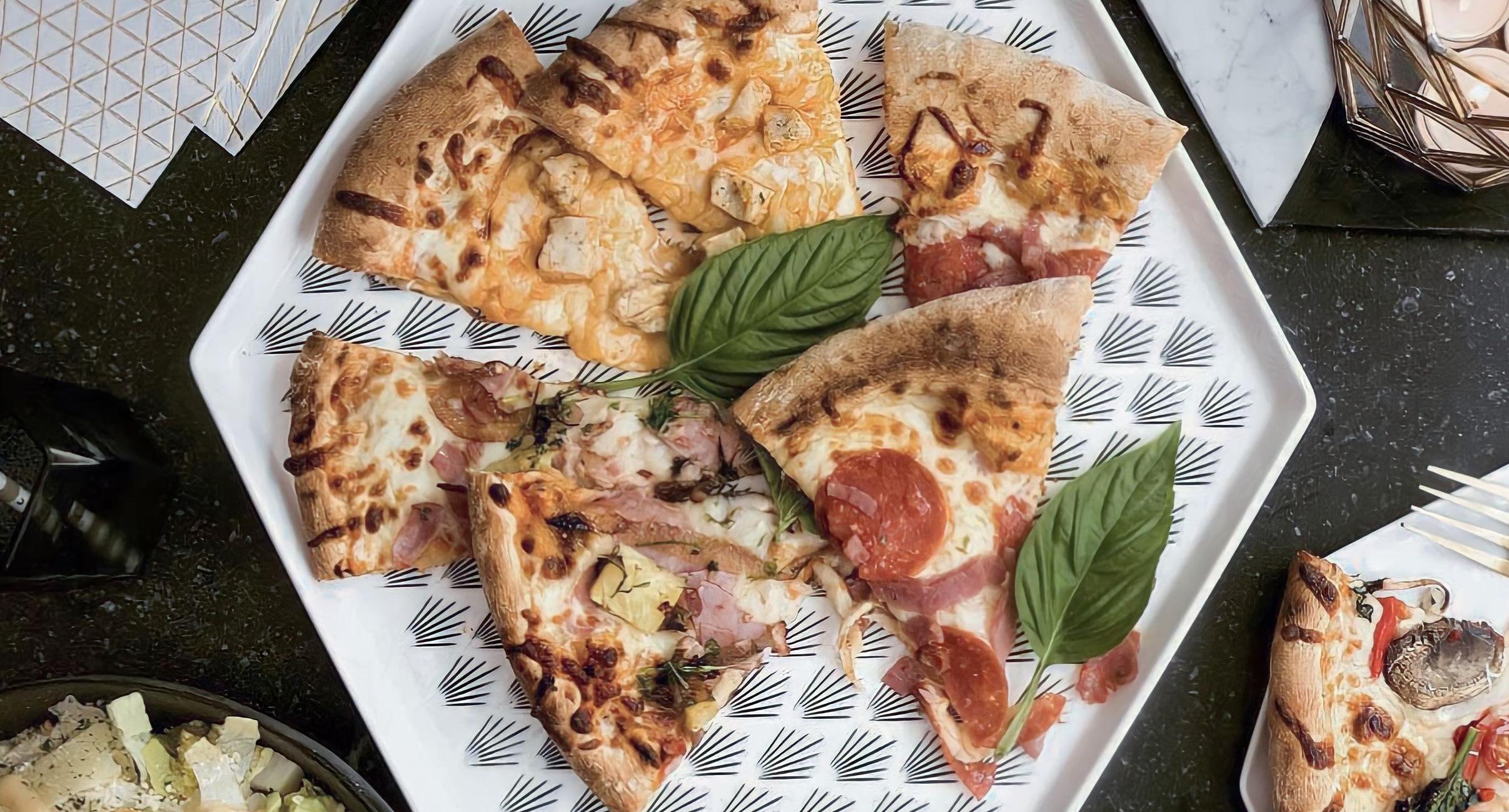
See what’s on the menu when these makers are on the road.
Need some inspiration? Or maybe you’re just looking to expand your knowledge of the growing pizza scene.
We asked a handful of pizzeria owners what shops they must hit while they’re traveling—and it can’t be their own. Take a look at where they say which restaurants, or pizza experiences, make a can’t miss slice and why. You might just want to add it to your itinerary for your next road trip wor casual dining adventure.
Erica Barrett (founder, Dough Boy Pizza Co.): My go to pizza place to visit is Stella pizza in New York in the meatpacking district. My go to order is a slice of white pizza with marinara on the side. I don’t know the owner but the staff is always amazing. What makes this place special is it’s a small corner pocket location just like Dough Boy. I love when people take small spaces and do great things.
Khanh Nguyen (founder and CEO, Zalat Pizza): Whenever I travel, I make it a point to check out the toprated pizzerias, especially in places like New York City and Chicago, known for their iconic pizza styles. In New York City, I love to dive into the pizza scene by sampling slices from spots that top the 'Best Pizzas in New York's lists. There's something exciting about comparing these

acclaimed pies with what we offer at Zalat Pizza, and I often find that our pizzas stand up quite well against these famous names. While I’m a die-hard thin crust pizza guy, there is also room in my pizza life for a great Chicago deep-dish several times a year. As for must stops: Bleecker Street Pizza in New York City!
Ric Gruber, Jr. (CEO, Billy Bricks Restaurant Group LLC): Whenever I travel back to Connecticut where I matriculated at Fairfield University, I make a trip to New Haven on the way from the Hartford airport and stop at Frank Pepe's. Before Pepe's was all the rage and Dave Portnoy made it world famous, it was regionally well known and never disappointed. My go to is always a cheese, margherita, or the menu item a place is most well known for. At Pepe's I can't resist their clam pizza.
Bruce Irving (founder, Smart Pizza Marketing): I travel quite a bit to the city of Orlando throughout the year, every single time I go I have to stop in to Bruno’s Pizza. My favorite is his new spot in College Park. He serves New Jersey-style pizza and although Florida gets a bad rap when it comes
to pizza this may be my favorite place.
Cindy Hayward
Hungry for some new-to-you pies? Here are some of our contributor’s favorites.
(co-owner, The Pizza Place on Noriega): Sometimes food doesn’t have to be the best or your favorite, but the smell, and the taste of the food is obviously linked to memory and some of my best memories are at these pizzerias. Friday night was our pizza night growing up and we would either go to a place called Pizza World or Round Table. When I met my chef husband, we already shared a love for pizza and when we travel back east to see family, we have places that we like to visit. The north end location of Pizzeria Regina.
Frank Speranza (national sales manager, Foodservice): Pittsburgh is one of my favorite pizza cities outside of my home New York/ New Jersey market. In Pittsburgh it's Mercurio's for their Neapolitan Salsiccia pizza, Iron Born for their Detroit Style Spicy Pie, and Pizzeria Davide for their New York-style Davide's Famous Old World. Three unique places with three completely different styles of pizza.

CREATING AN EXPANSION BLUEPRINT FOR YOUR PIZZERIA
By Ric Gruber, Jr., CEO, Billy BricksAs the aroma of freshly baked pizzas fills the air and customers line up for your slice of heaven, the thought of expanding your business becomes increasingly tempting. However, before taking the plunge into expansion, it's crucial to craft a strategic blueprint that outlines your path to growth. I’m here to guide you through the process of creating an Expansion Blueprint for your pizzeria, and to provide you with a checklist of questions to ensure expansion is right for you.
While the Billy Bricks journey is well underway, yours may just be getting started and I’m honored to be given a platform to share our story and what we’ve learned along the way to help you scale your pizzeria or decide less is more for you.
BELOW I’VE OUTLINED EIGHT STEPS TO GROW AND SCALE YOUR PIZZERIA. HOPE YOU’RE HUNGRY FOR SUCCESS.
Every business should start with a Business Plan, but that’s just step one. Once you’ve proven your concept works (at least at your first location), you’re ready to open up location number two (or mobile unit) and it’s time to craft a detailed Expansion Blueprint. Explore potential locations or vehicles, assess market demand, and establish clear goals. A wellthought-out plan is the flour that will bind your ambitions.

YOUR PIZZA ODYSSEY
While we refer to our journey as a metaphorical ride on a pirate or rocket ship at Billy Bricks, there is no course to plot that avoids the inevitable need for capital and what that requires is your own mastery of your business by the numbers. You’ll need to get back to the basics of a pros and cons list around your funding options, whether it's through loans, investors, or organic growth and use of your own cash flow. In all cases, you’ll need a financial strategy that allows you to weather the challenges that may arise during expansion and avoid being over leveraged and operating under financial duress.
Your team is the cheese to your pizza – essential for flavor and success, so don’t skimp, cut corners or costs on either. I emphasize the “YOUR” because at the end of the day it’s your business and your team should match environment and culture you’re trying to build as the leader
as it will be a reflection of you and with the amount of time you spend on your business, you should do yourself a favor and choose to work with people who make it more, rather than less, enjoyable of an adventure. Nothing will take you higher or lower faster than having the right talent AND culture to ensure consistency in quality and customer experience across all locations.
If you haven’t realized it yet, the future is always now. You need to be curious enough to explore the many roles of technology in scaling your pizzeria, but discerning enough to know what and when there is a solution that works for you. Avoid following every trend being implemented which could create a chaotic environment. However, some things such as streamlined ordering systems and digital marketing must be embraced for greater efficiency and customer engagement as you grow.
continued on next page
continued from previous page
Maintaining the essence of your brand is paramount during scaling. As my dad would always say, “stick with the one that brought you to the dance.” As you’re scaling and innovating, don’t lose your core competencies, focus or values; they are your North Star. You’ll need to create strategies for ensuring consistency in branding, from simple visual elements to the overall customer experience. A consistent brand is a powerful magnet for loyal customers.
Scaling doesn't mean losing touch with your local roots. In fact, some of the most effective and least costly means of engagement or the ones closest to home. Explore how community engagement initiatives can foster a sense of connection and loyalty among your customers, both at your original location and new ones. At Billy Bricks, we regularly host fundraisers, pizza making classes, donate gift cards to events, and get out and about with our several mobile units to connect with our communities.
Maintain a commitment to operational excellence as you expand. Said another way, the way you do some things is the way you’ll do everything. Keep your standards high (especially for yourself) by creating an

environment that sets expectations through clear and consistent communication and holds everyone accountable. Having this type of organizational environment will allow you to collaboratively optimize your processes, from supply chain management to kitchen operations to ensure that the quality of your pizzas and experience do not crash.
Lastly, and perhaps most importantly, scaling comes with its share of surprises. Remember, the hardest parts are usually the times where you and your business are growing the most and it’s important to stay flexible and adaptable in the face of challenges. The ability to pivot and adjust your strategies can be the secret sauce that ensures your success.
To download the checklist, visit https://www.pizzaric.com/ s/stories/pizza-rics-pizzeriascaling-checklist.
Scaling your pizzeria is a thrilling journey that requires careful planning, passion, and a bit of crazy. As you embark on your adventure, remember that every slice you
You’ll need to create strategies for ensuring consistency in branding, from simple visual elements to the overall customer experience.
serve tells a story – a story of belief, commitment, growth, a refusal to fail, and the irresistible joy of pizza. Enjoy the ride!
Ric Gruber, Jr., wears many hats. At Billy Bricks Restaurant Group he serve as an owner and as general counsel, leading the charge for the company's structure and growth of both the Billy Bricks & ZZA BABY concepts.
Graduate of the University of Illinois Chicago-John Marshall Law School, Gruber has been an attorney licensed since 2013 in Illinois and California with an LLM in Information Technology & Privacy Law.
With a passion for creative arts and recognizing a clear market need for many of Gruber’s law practice clients, he co-founded Brandless; a digital creative and experiential marketing agency.
You can follow along with Gruber’s restaurateur career here (@billybrickshq & @ moojoesicecream)

You've eagerly awaited this moment your whole life— dreaming of officially becoming the boss. What are the do's and don'ts? How do you continue the legacy and build upon the foundation you've now taken over?
Whether acquiring your family's business, inheriting it, or passing it on to the next generation, owning your restaurant is a new ballgame in a league of its own. I served as the main operator of my family's pizzeria for nearly two decades before officially taking ownership. I thought I
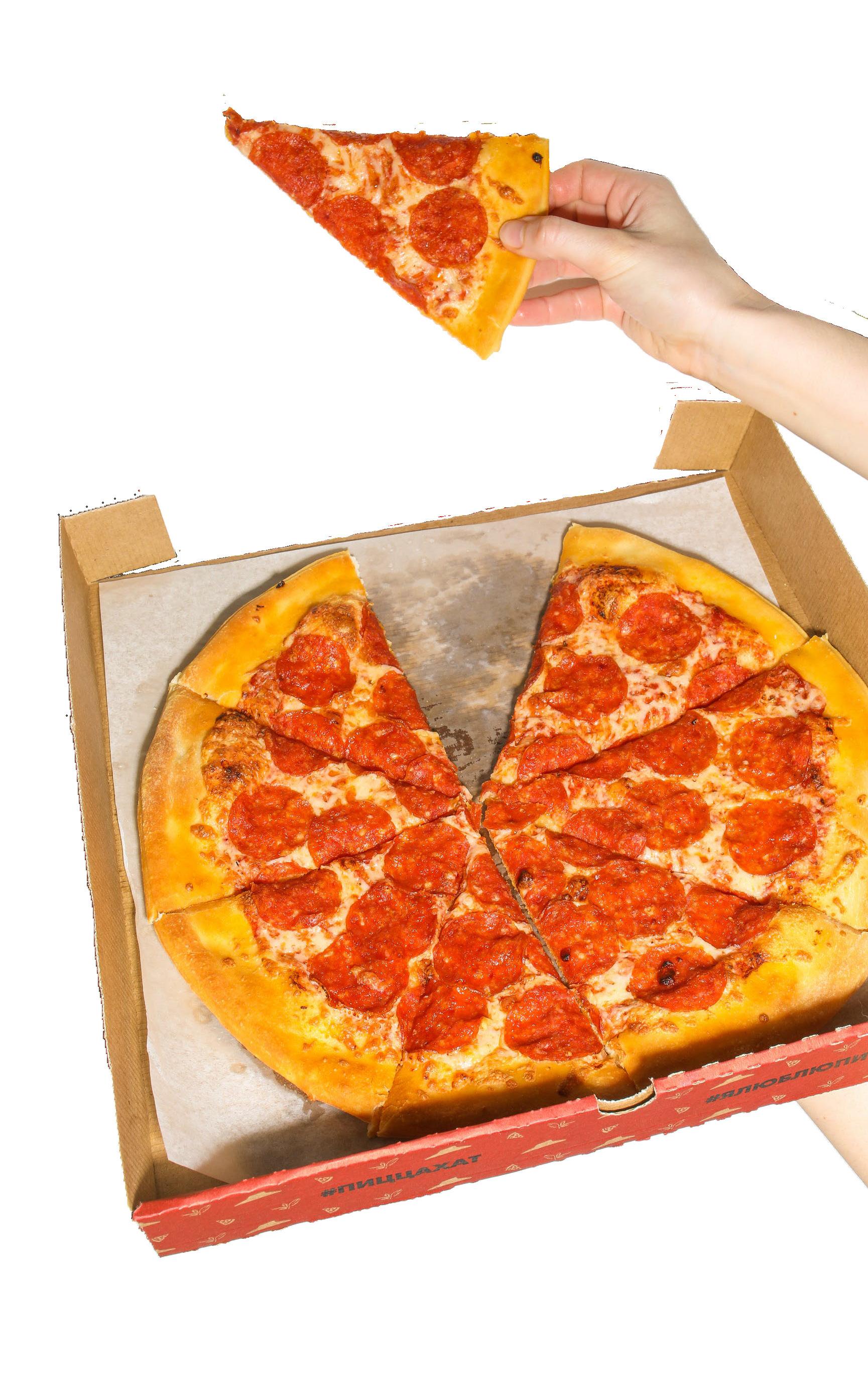
it's partially true. While 90% of you have a passion driving your decisions, the other 10% may have taken a unique path. That's okay! With desire and ambition, success is achievable.
In your first few months or even first year, avoid distractions like new ideas, concepts, facelifts, equipment, and social media.
for a new S-corp. This choice allowed me to benefit from continued depreciation of equipment and other assets.
continued on next page
continued from previous page
Forming new leases, dealing with attorneys, filing fees with the state, and other business matters were crucial steps in taking control. My advice is to assemble a reliable team of professionals—those you can trust, even if they weren't part of the previous years. It's time to change up the old guard as you embark on writing your own story.
When I fully took over, much of my time shifted from being the workhorse in the kitchen to spending more time in the office. The workday didn't necessarily end with the business day but extended to my home office. Gaining access to bank accounts, vendor payment platforms, credit card processing, and analyzing reports more closely to maximize profit added a different weight when every penny leaving the bank account is yours. As the quality control
person, leaving the pizza dough and sauce to your employees can be devastating—your hands must be in the dough.
Our editor, Bruce Irving, once told me that being passed the torch is like becoming president—bright ideas and energy often lead to following the same path. The same holds true with ownership. In your first few months or even first year, avoid distractions like new ideas, concepts, facelifts, equipment, and social media. Changes are inevitable and will take their course in due time. Patience is key; you're in this for the long haul. Spending all your time on TikTok may make you lose sight of what's happening in the store. Those on social media platforms often have a second family member operating the store while they chase stardom.
Stick to what works. If expanding your menu is a goal, start slow. Introducing new side orders and appetizers slowly can be a huge hit. The profit margin on sides is typically on the larger side. Through marketing, email and SMS platforms, I reached out to 13,000 customers about our new
products monthly. Slowly introducing limited time only gourmet pizzas and creating a buzz proved successful—what stuck, stayed; the rest were cut from the roster.
Hiring a publicist was something I never considered initially, but it proved invaluable in capitalizing on industry celebrations. National Pizza Month, National Cheese Day, Cheese Lovers Day, Pi Day—these are opportunities for operators to introduce incentives with photography and entice customers.

You'll learn that you can't always be a people pleaser. Knowing the majority of my customers by name and details about each one, being present becomes challenging as sales soar. Balancing interactions with third-party delivery drivers, daily salespeople, employee excuses, customer reviews, and the wear and tear of daily operations requires a bit of selfishness. Have fun with it, keep the flame burning, and, most importantly, never forget who the boss is. Best of luck, my friends. I'd be happy to hear about some of your experiences.
George Panagopoulos is the owner/ operator of Dedham House Of Pizza.
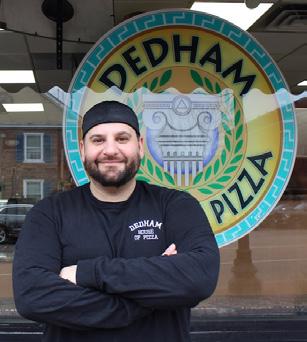
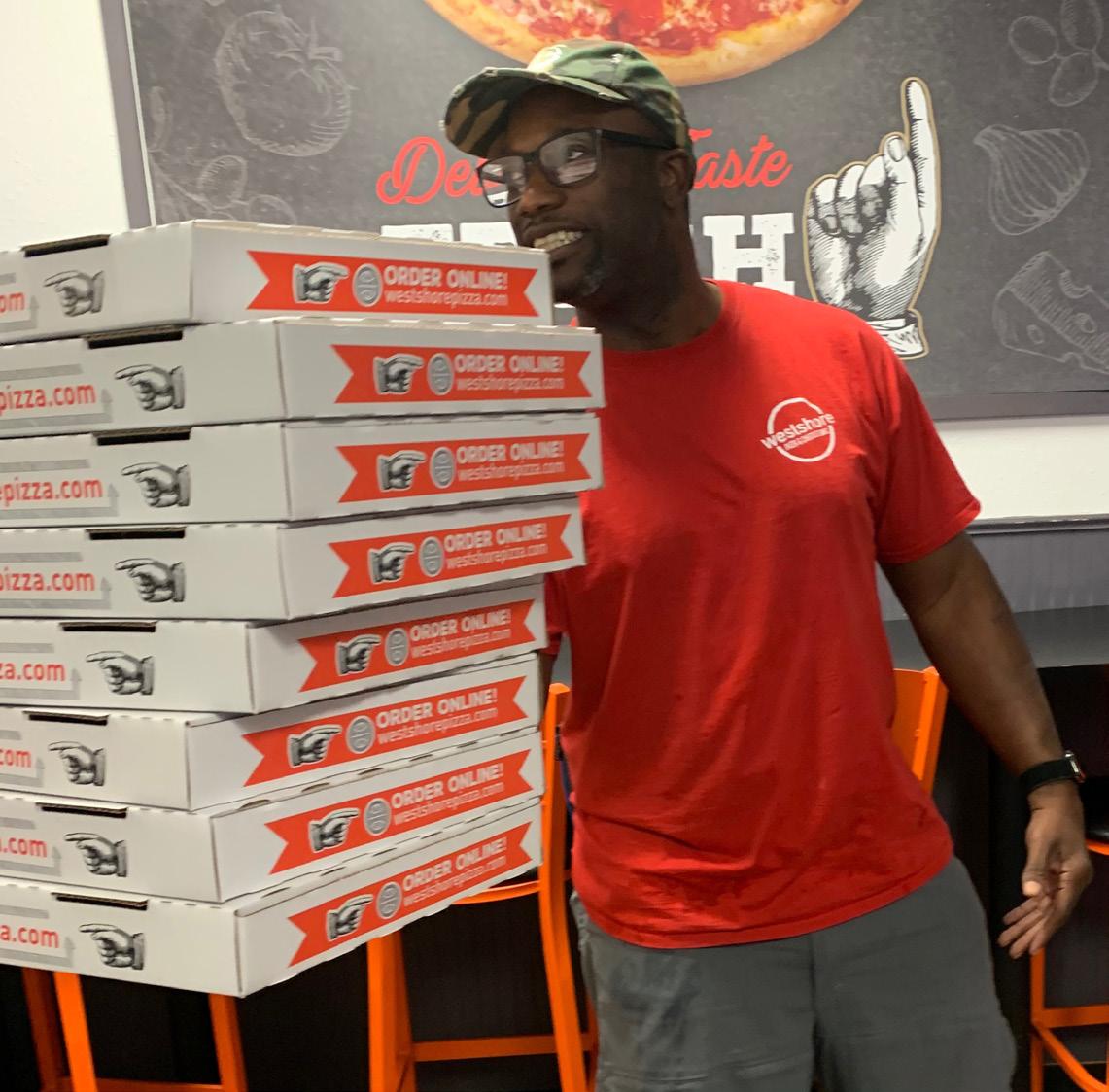
Reed shares, “My first taste of ownership came from a group of people who wanted to invest in me. Sweat equity.”
One of the biggest mistakes I see new franchise owners make is depending solely on the marketing from the brand to drive traffic.
TYRELL REED, Westshore Pizza franchiseeWestshore Pizza franchisee Tyrell Reed shares his experience and keys to success.
Are you looking to begin your career in the pizza industry but aren’t sure where to start? Maybe you don’t quite have the capital for a solo venture or you might not have the bandwidth or name to grow a loyal community of customers. Maybe you’re just looking for a side venture in a food group you love. Franchising might be the path for you!
If you take the route of a franchisee, you are investing in a business with a tried and true brand that has a built-in following, procedures and tested recipes. We connected with Tyrell Reed, a franchise executive and multi-unit franchise owner. Over the last 20 years Reed has climbed the ranks in the industry from dish washer to multi-unit franchise owner.
Reed has served in senior leadership roles with multiple brands including Westshore Pizza, Fuzzy’s Taco
Shop, Checkers/Rallys & Moe’s Southwestern Grill.
In our inaugural issue, Reed shares his experience and keys to success as a franchisee of Westshore Pizza–a chain that originated in Tampa, Florida. Westshore Pizza is a fastgrowing concept boasting nearly 20 operating locations today in Florida and more committed to open. Hungry for more insight from Reed? You can explore his article “Laying The Foundation: Why Team Building Matters” on page XX.
SPM: What made you decide that investing in a franchise was the right fit for you?
Tyrell Reed [TR]: I would say my path wasn’t the traditional route for someone looking to invest in a
continued on next page
continued from previous page
franchise business. I’d spent years working in the brand, managing multiple locations, and on the corporate operations team. My first taste of ownership came from a group of people who wanted to invest in me. Sweat equity.
SPM: Can you touch on some of the first steps you took to become a franchisee?
TR: I spent years learning the brand and improving my skills as an operator. That experience proved to be invaluable once the problems became mine to solve.
SPM: What are some tools every franchisee should have or invest in to run a successful location?
TR: Technology. You don’t have to be first, but it could be costly to be a late adopter of industry changing technology.
SPM: Would you say that any specific type of background would help before investing in a franchise location?
TR: Having experience managing people or leading teams is important.
Coming from a background that emphasizes communication and collaboration will help you get things done in the pizzeria.
SPM: How much involvement and/or guidance does a franchisee usually receive from the company? Is there any room for creative freedom?
TR: That really depends on the brand. A well-established brand may have less room for creative input but offer more support and guidance. Creativity becomes more structured in the form of test groups or steering committees. Smaller units or newer brands lean on the input and feedback from franchise operators to help improve products and processes.
SPM: Do you have any tips for marketing as a franchisee?
TR: One of the biggest mistakes I see new franchise owners make is depending solely on the marketing from the brand to drive traffic. Always have a local marketing plan to accompany the brand awareness efforts. Also, don’t be afraid of the things you don’t fully understand. Take the time to learn them and capitalize.
SPM: Which specific channels are best to invest in, from your experience?
TR: I’ve always had success investing in cross-promotional opportunities with other local businesses and organizations. Seeing our banner at a high school or a big stack of Westshore boxes at an event helps us sell to people who would not have known about us otherwise.
SPM: Is there anything you wish you would have known before franchising?
TR: I wish I’d known how important relationships were to our long-term success. This is a very tough business to build on your own. Having the right people on your team, the right vendors, and the right support will help you grow your business the right way.
SPM: What is your advice for someone looking to become a franchisee of a pizza restaurant?
TR: Spend as much time as you can learning the business before you invest your dollars. Go work for someone who is established. Ask them lots of questions.

Coming from a background that emphasizes communication and collaboration will help you get things done in the pizzeria.



Welcome to We Can Pizza That (a tribute to one of my favorite Portlandia skits), and a good summary of how I feel about what can be put on a pizza. This column aims to provide some ideas you can use at your pizzeria, as well as some insight into how we at Maipai Tiki and Pizza Bar come up with our creations and where we find inspiration.
Our pizzas usually go through a few rounds of testing before we put them on the menu, but every now and then we get lucky and nail it on the first try. Testing pizzas is a must, and family meals are a great outlet to test a new pizza and get feedback.
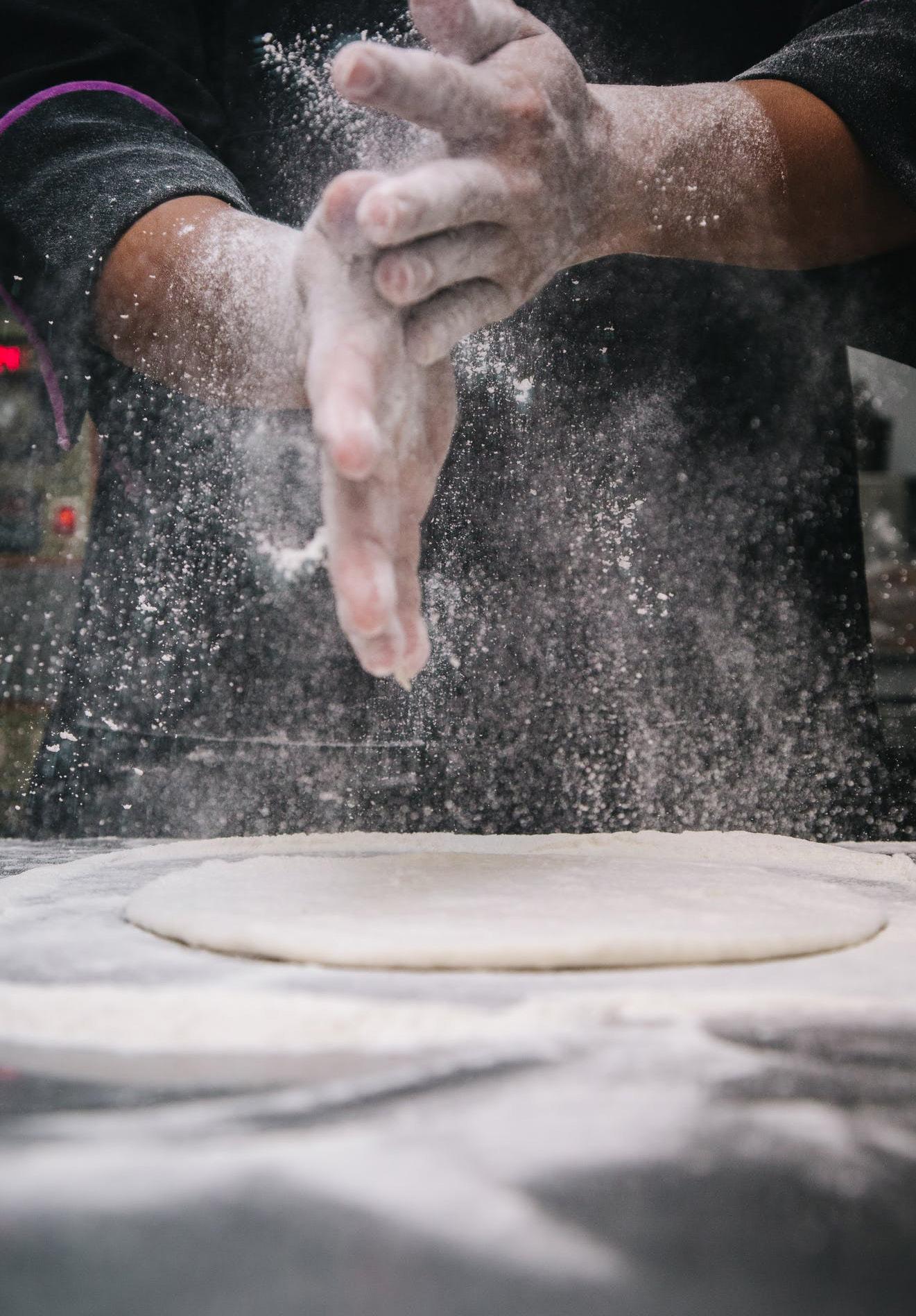
Our first feature pizza for this column is The Creature from the Crab Rangoon, inspired by the beloved crab rangoon appetizer. This was a customer request, and for those of you who don’t know, a Crab Rangoon is a delicious appetizer consisting of a crispy deep fried wonton wrapper with a crab and cream cheese filling. The Crab Ragoon was invented by Vic Bergeron in the 50s for his Trader Vic’s Tiki Bar, so it felt
like a given that we had to make a pizza based on this.
continued on next page
Creative features are a fantastic way to drive engagement on your social media.
Our post for this feature had a reach of over 16k+ accounts and 500+ shares, with almost 20% of that engagement coming from accounts that did not already follow us. Reaching 3,000 potential new customers from a single post is huge.
continued from previous page
This was one of the easier features to adapt to a pizza. We start with our standard Detroit pizza base, using a par-baked crust that has a 48-hour cold ferment and a blend of brick/ mozzarella cheese. We then pipe some dots of whipped seasoned cream cheese, and add chunks of crab surimi. We throw it in the oven for a finishing bake and when it comes out, it’s garnished with some deep fried wonton wrapper chips, sliced green onions, and a Thai Sweet Chili sauce.
The chips give it a really satisfying textural component, and this one definitely ended up being a crowd pleasure at our bar.
Give this one a try and let me know what you think! If you like it, feel free to add it to your menu as is, or tweak it to your own tastes! Note: Quantities listed below are for a 8x10 Detroit style pizza.

• Cream cheese
• Soy sauce
• Garlic powder
• Crab surimi
• Wonton/Egg roll wrappers (Avoid using spring roll wrappers)
• Thai Sweet Chili Sauce (Store bought brand recommendation: Mae Ploy)
• Green onions
1. Using a food processor or immersion blender, blend cream cheese, soy sauce, and garlic powder together, then place into a piping bag
2. Cut your crab surimi into
bite size chunks
3. Cut your wonton/egg roll wrappers into ribbons approximately 3”x1” and then deep fry until crispy and toss with a little salt to taste
4. Slice your green onions
5. Top your pizza with your favorite cheese blend
6. Pipe dots of the cream cheese mixture randomly around your pizza
7. Scatter crab surimi
8. Bake
9. Scatter some of your deepfried wonton chips and green onions on top
10. Drizzle your sweet chili sauce
11. Serve!
AUTHOR BIOSalar Madadi is the chef/owner of Maipai Tiki and Pizza Bar in Hamilton, Ontario, Canada. Maipai provides a completely immersive dine-in experience, with Detroit style pizza and tropical cocktails with a lot of fire and flare. Maipai has earned a reputation for coming up with creative pizzas, and has created over 70 unique feature pizzas in the four years since its founding. Maipai’s pizza philosophy is that anything can go on a pizza as long as the end result is delicious. This approach has worked at competitions and in business, and this year MaiPai really wants to push the boundaries of creativity.





